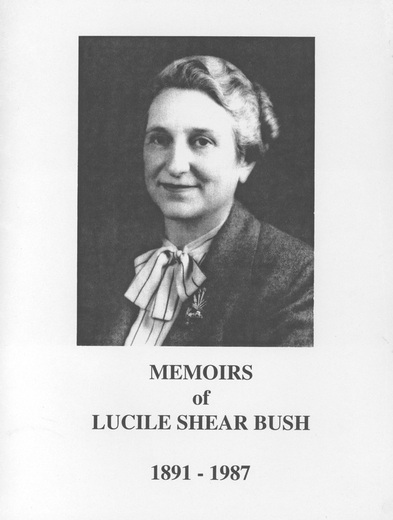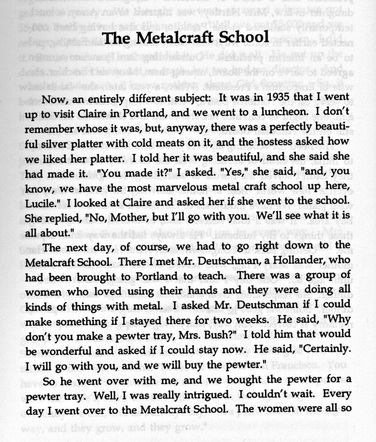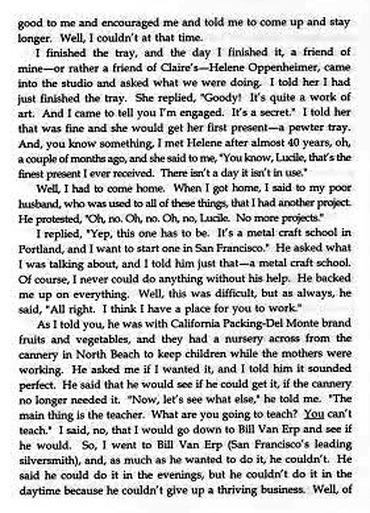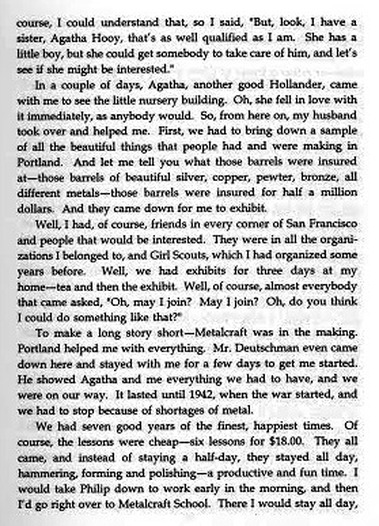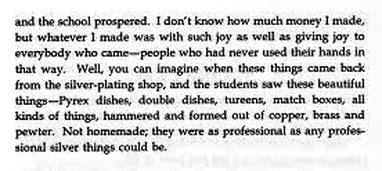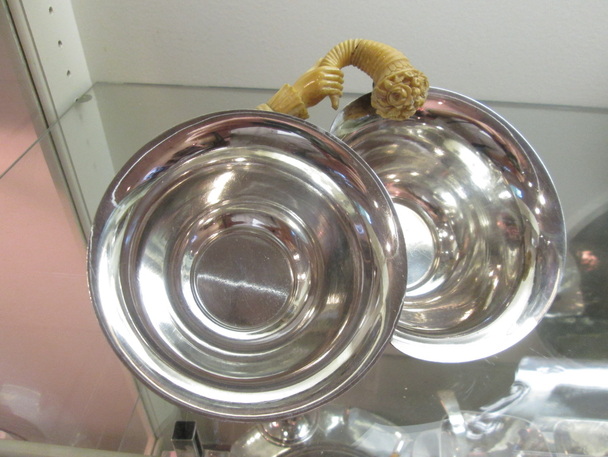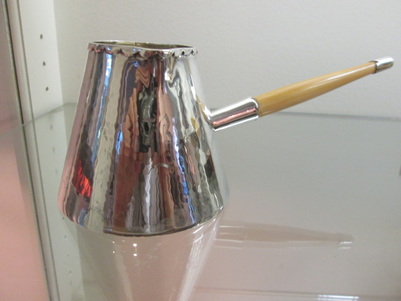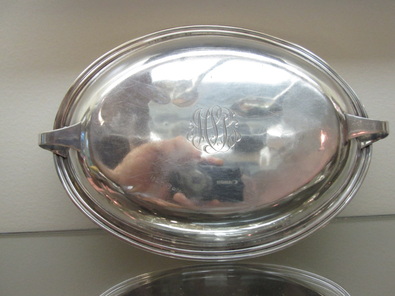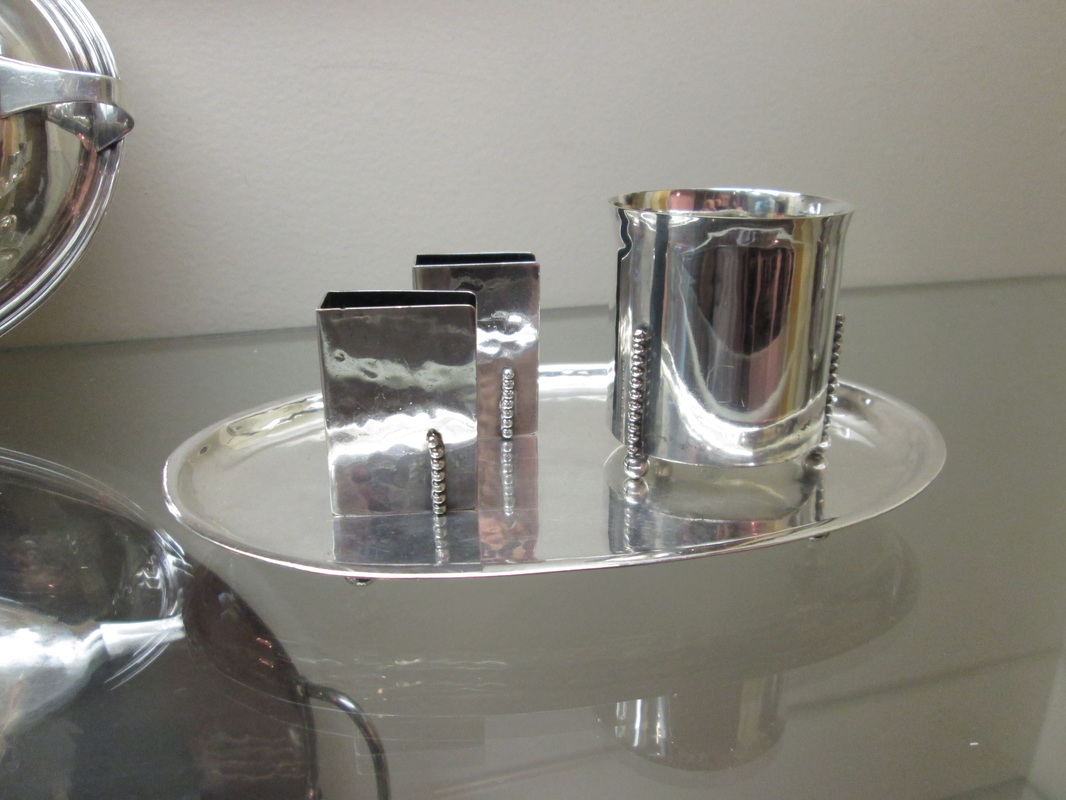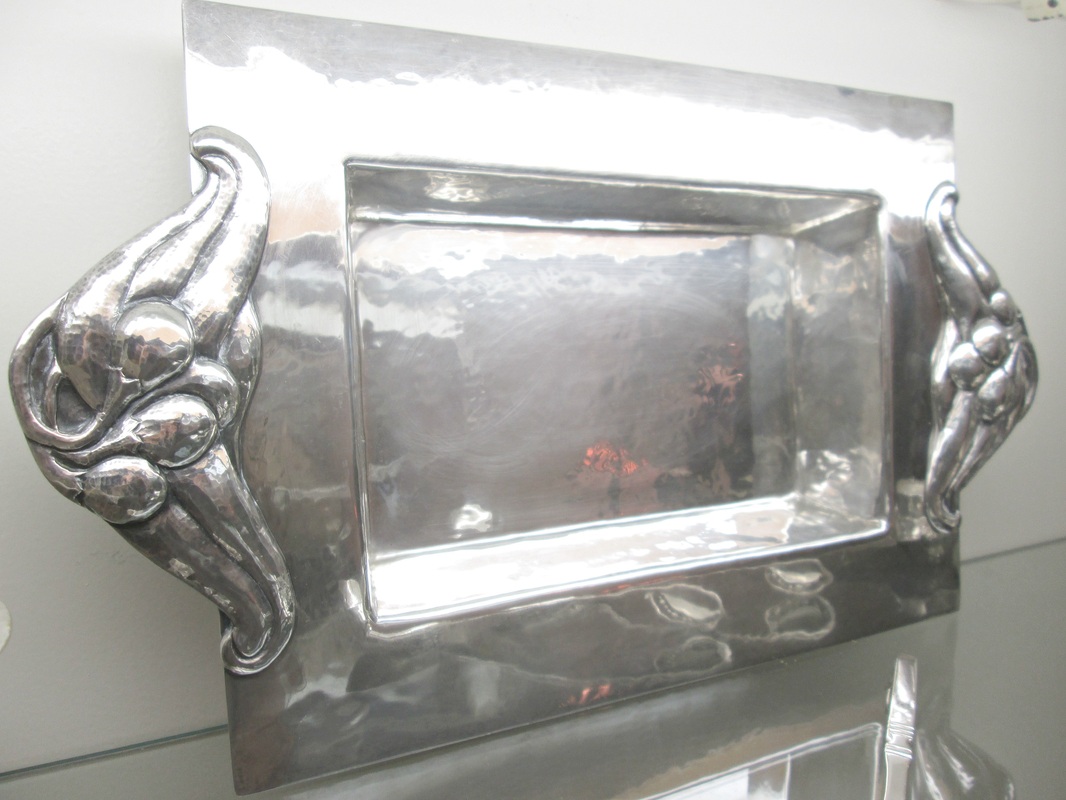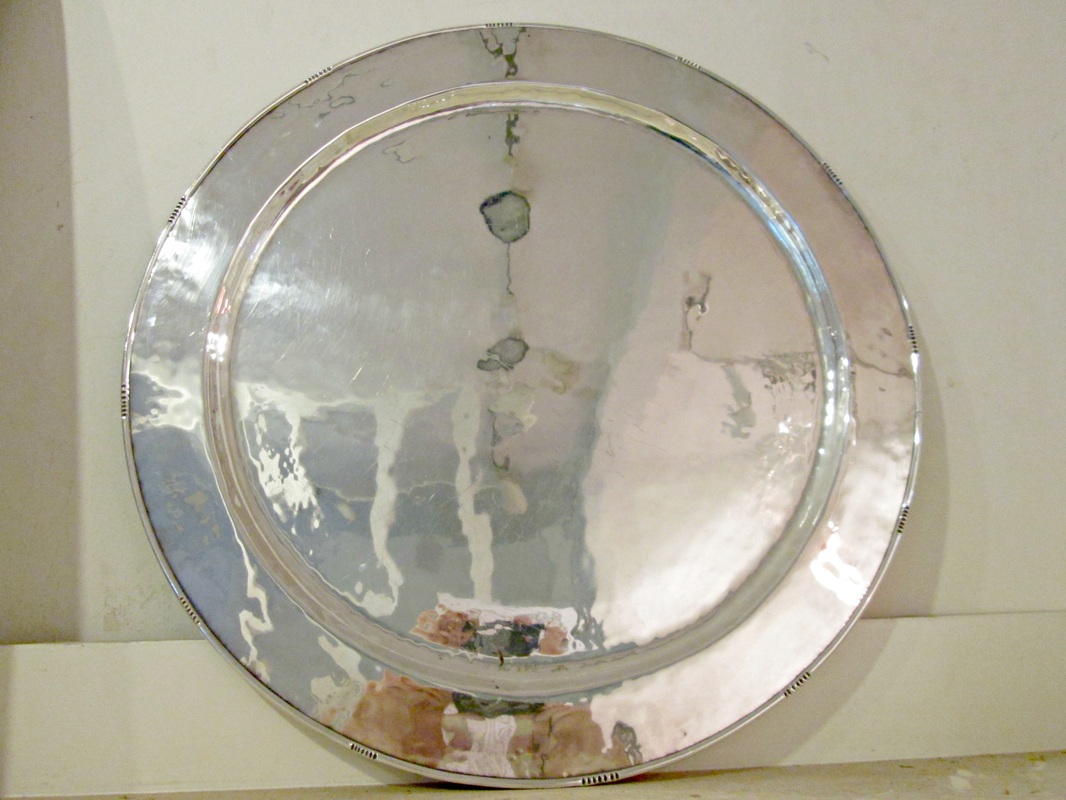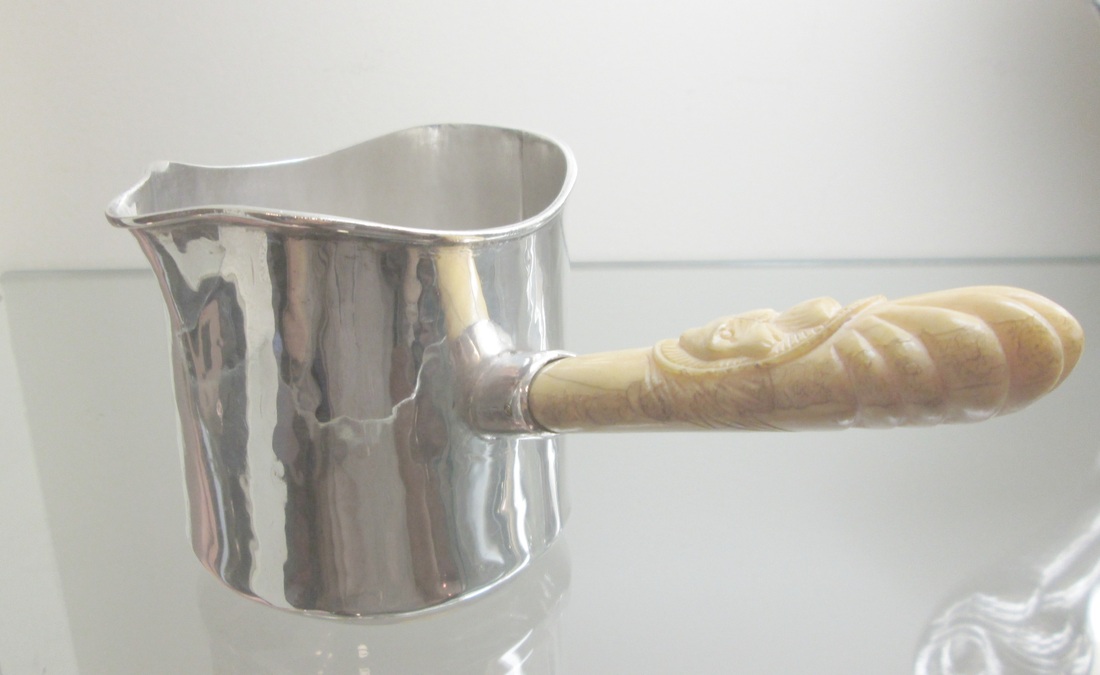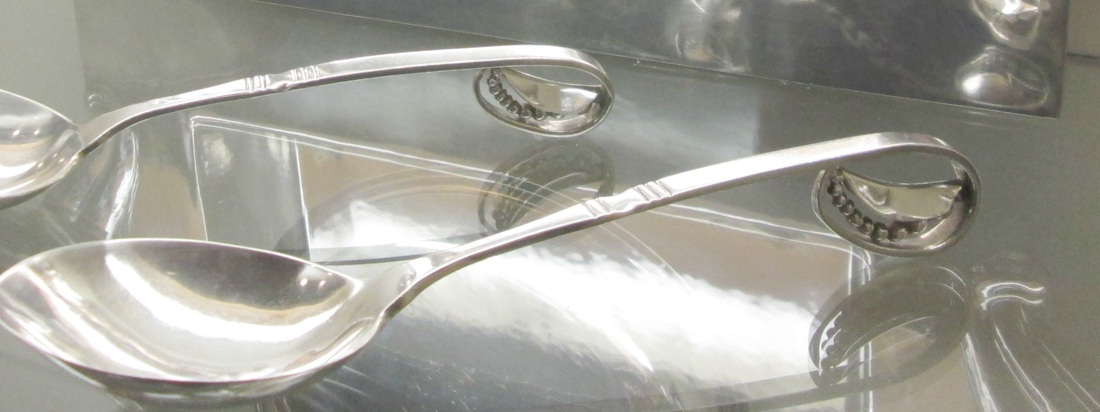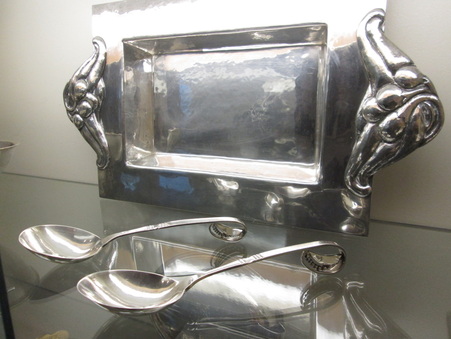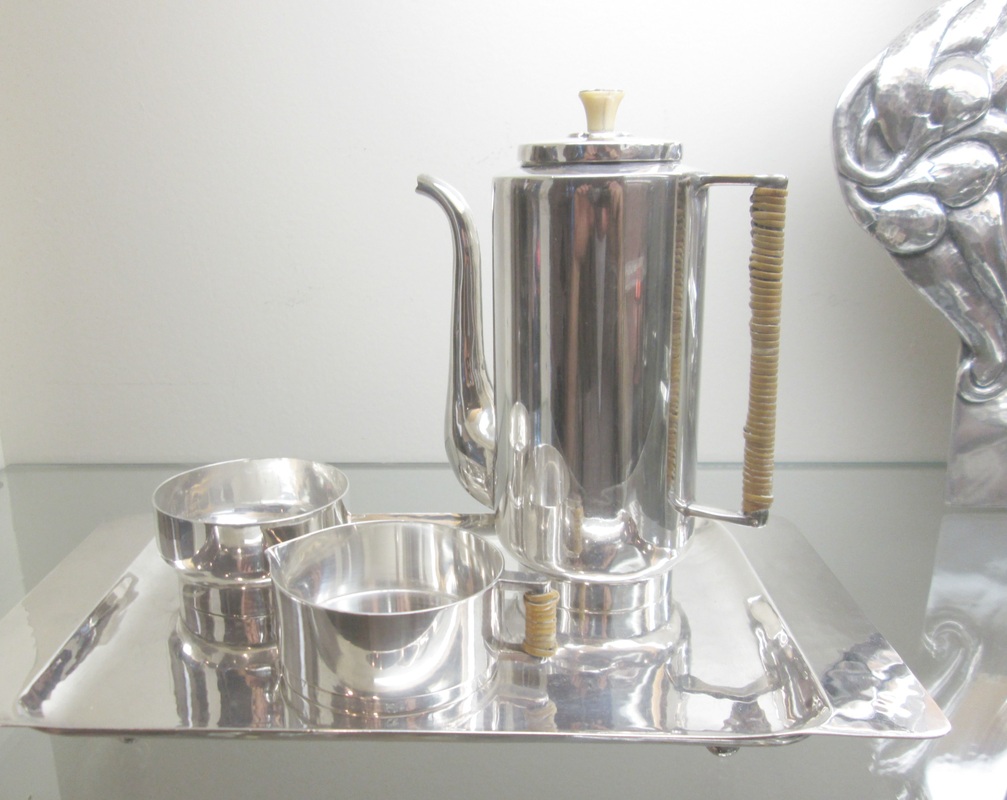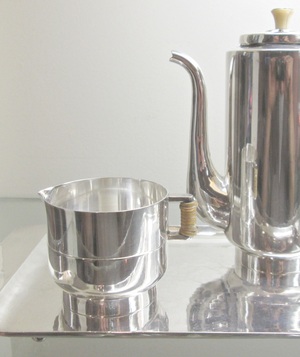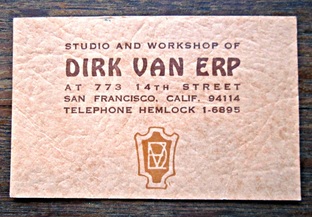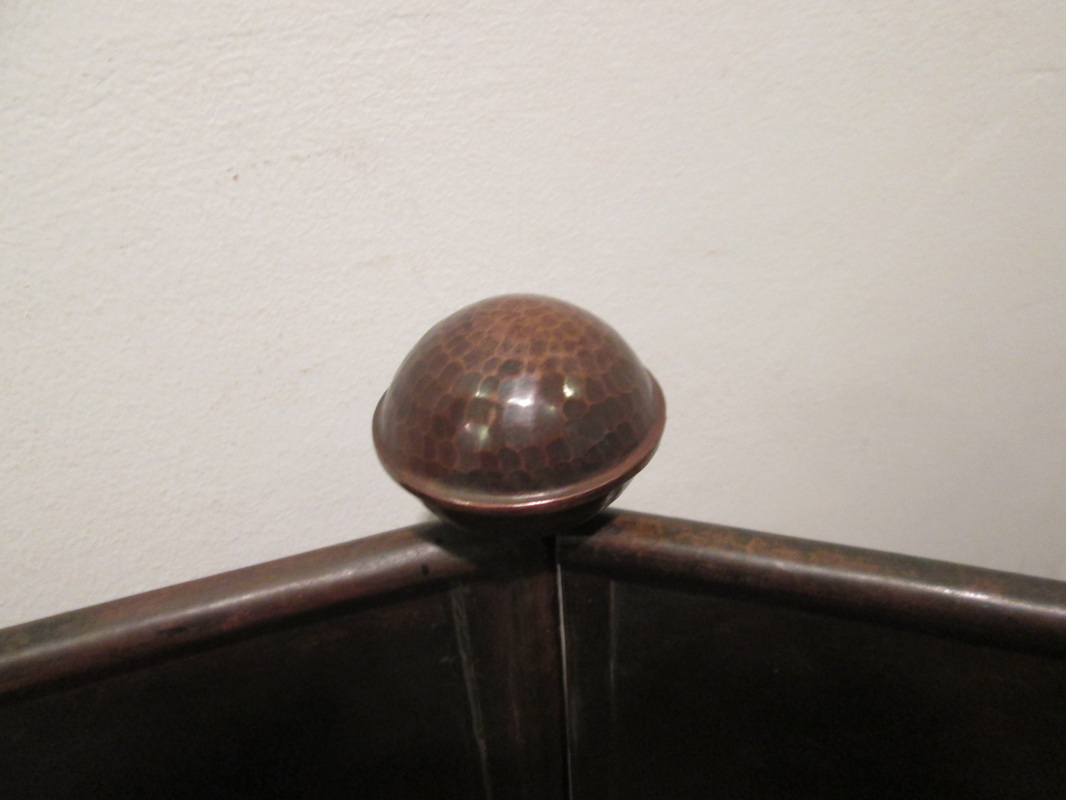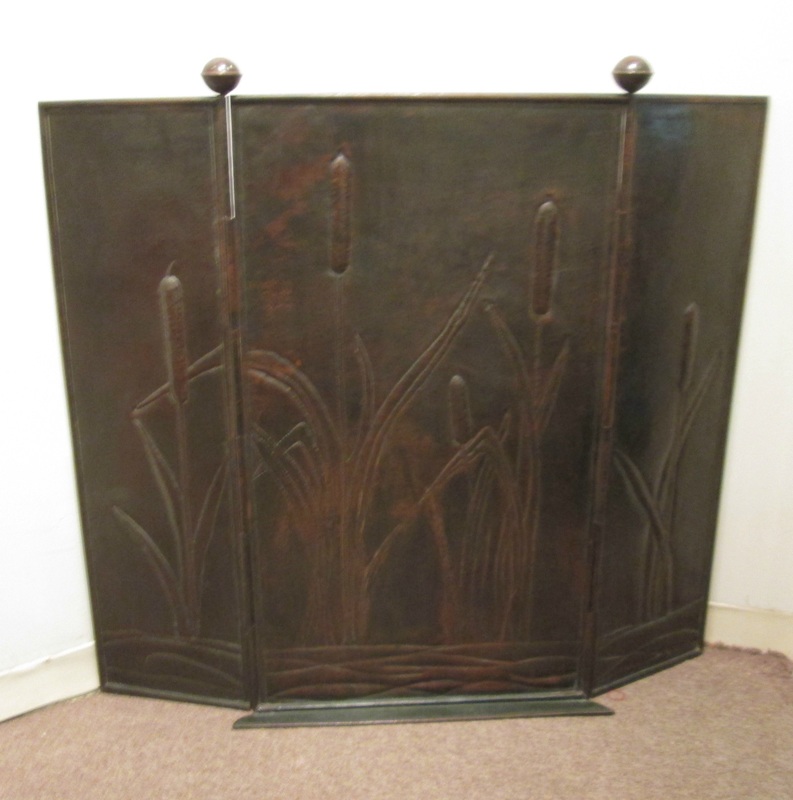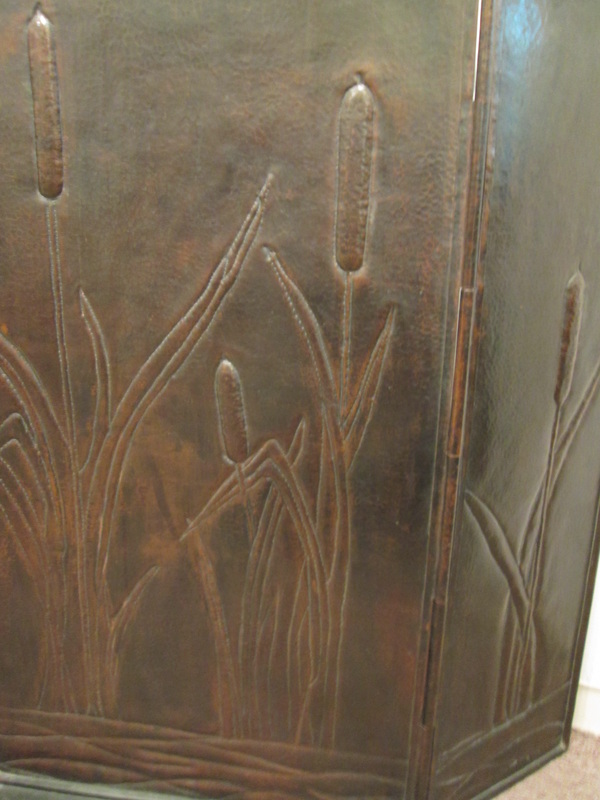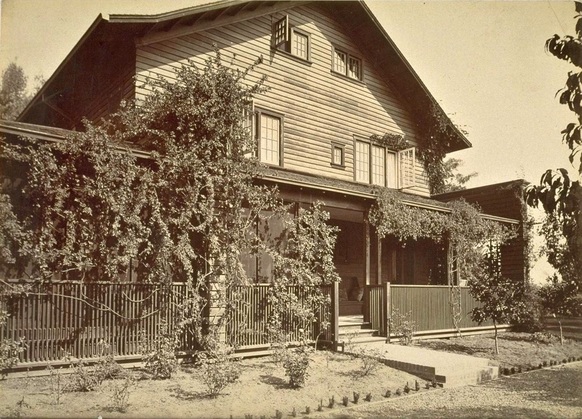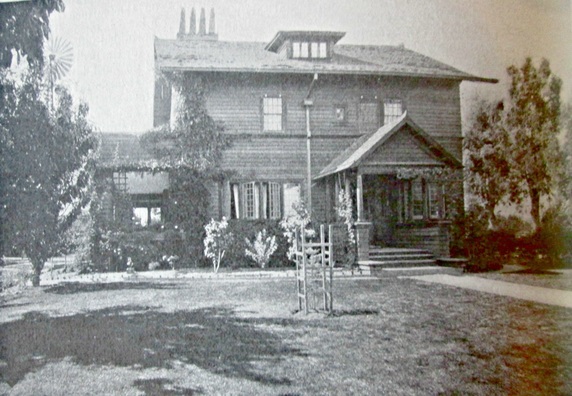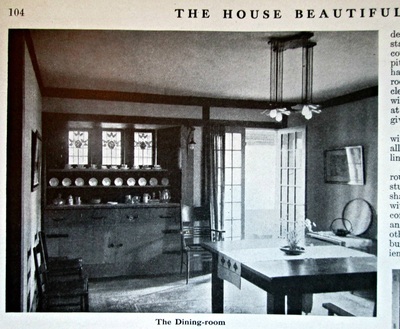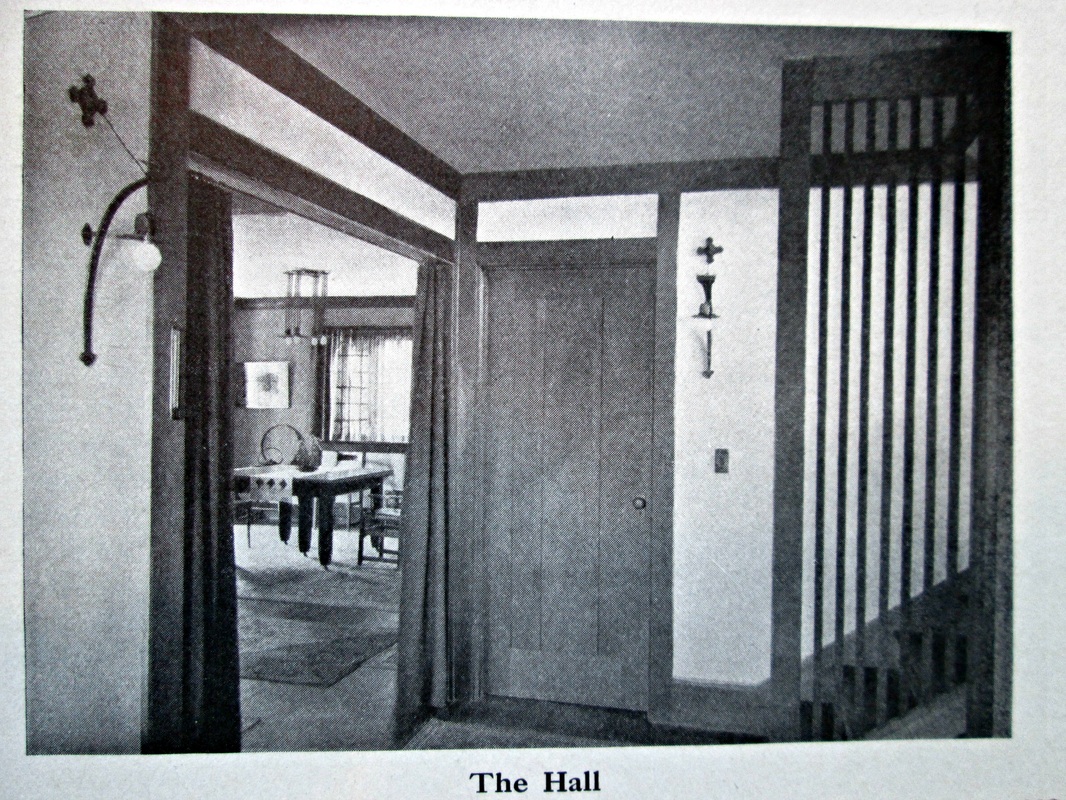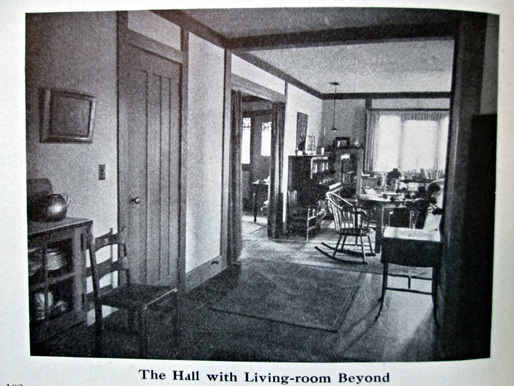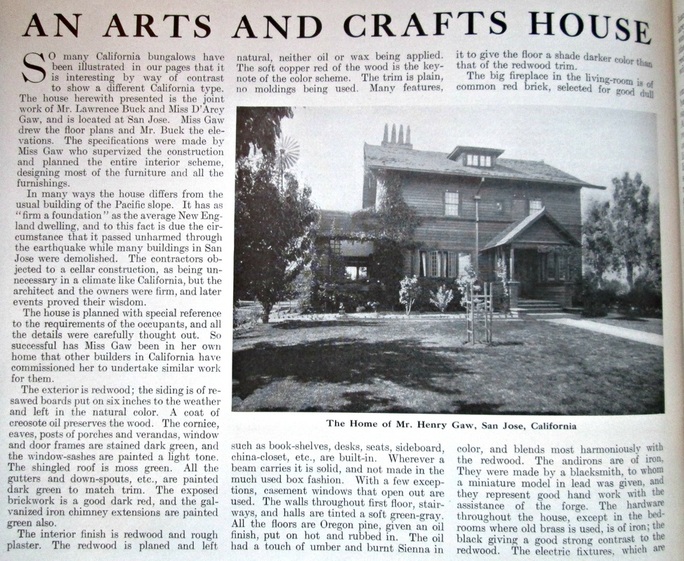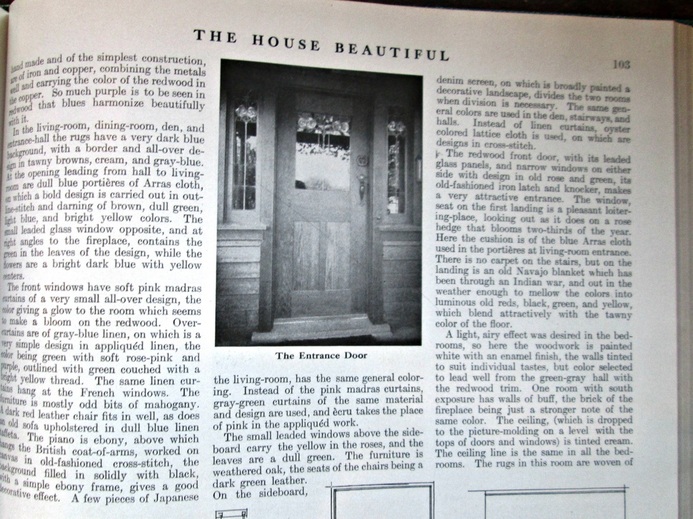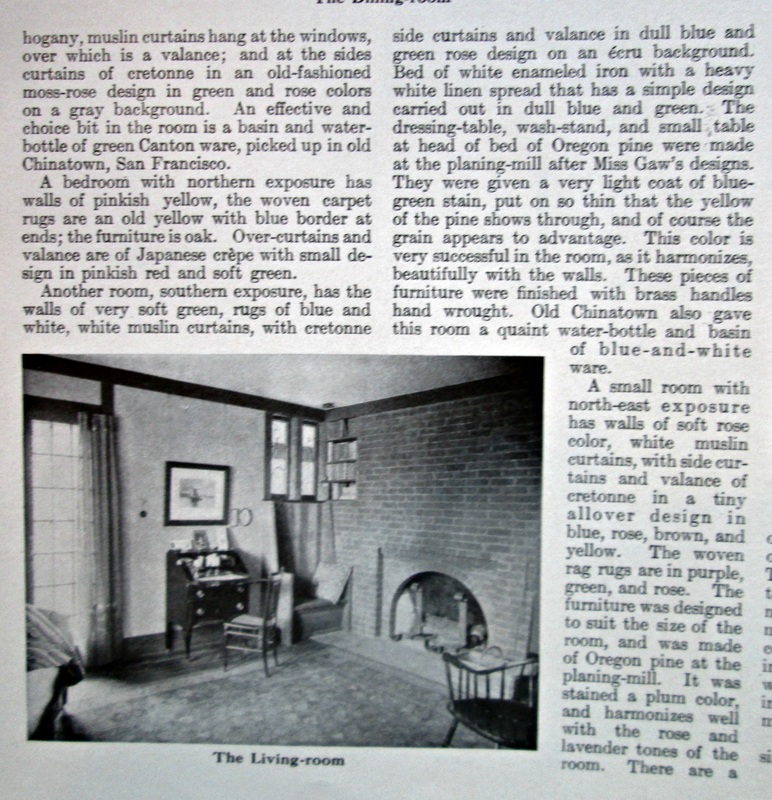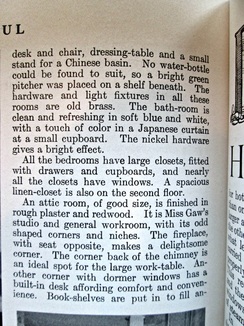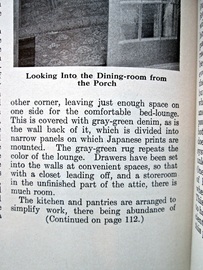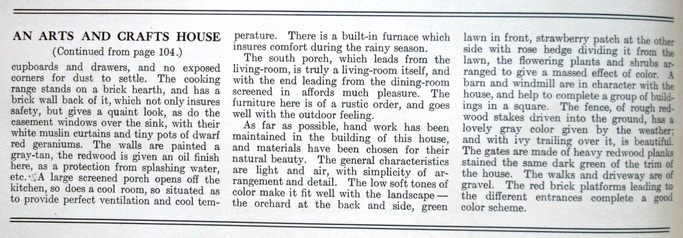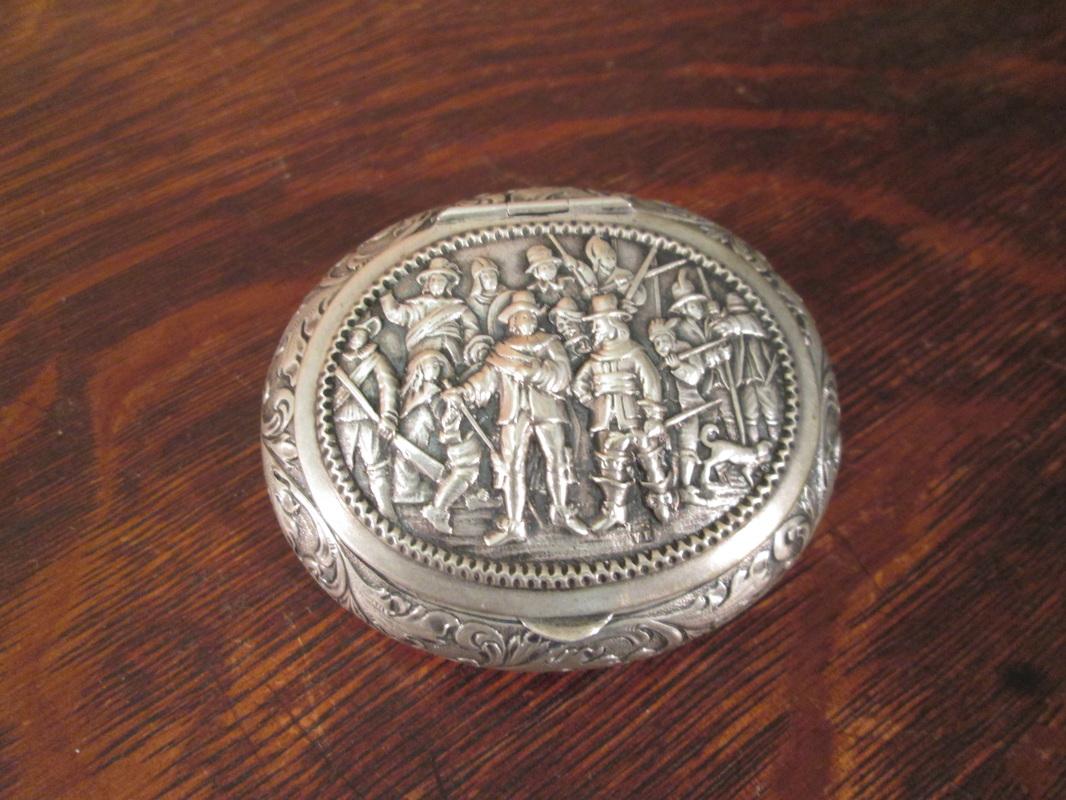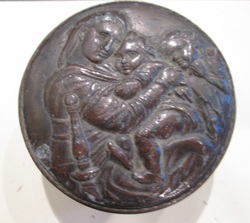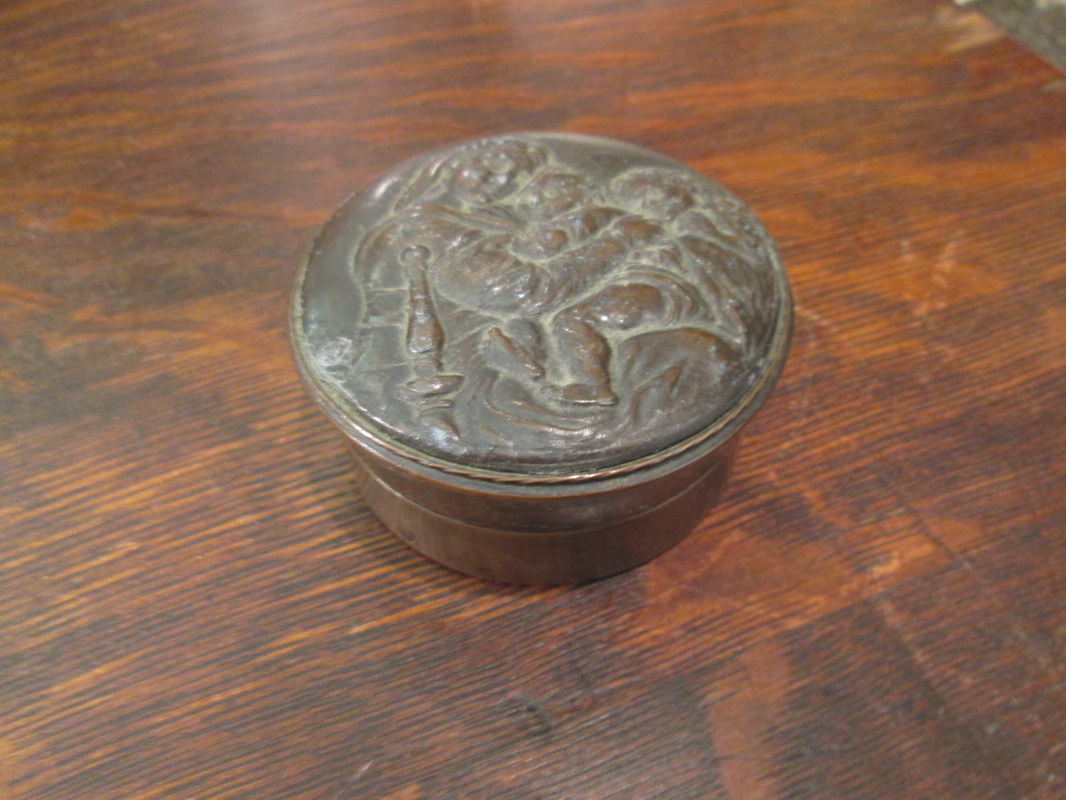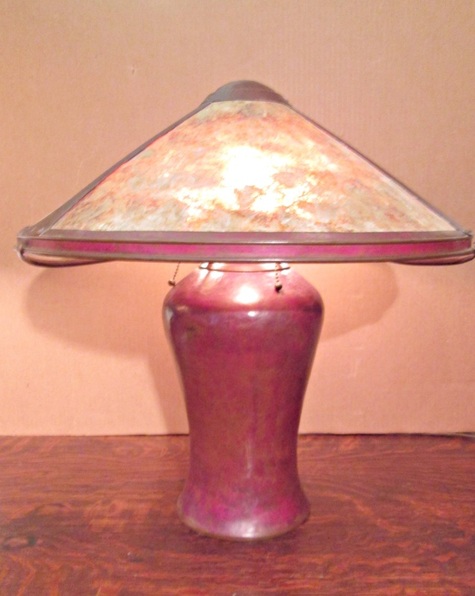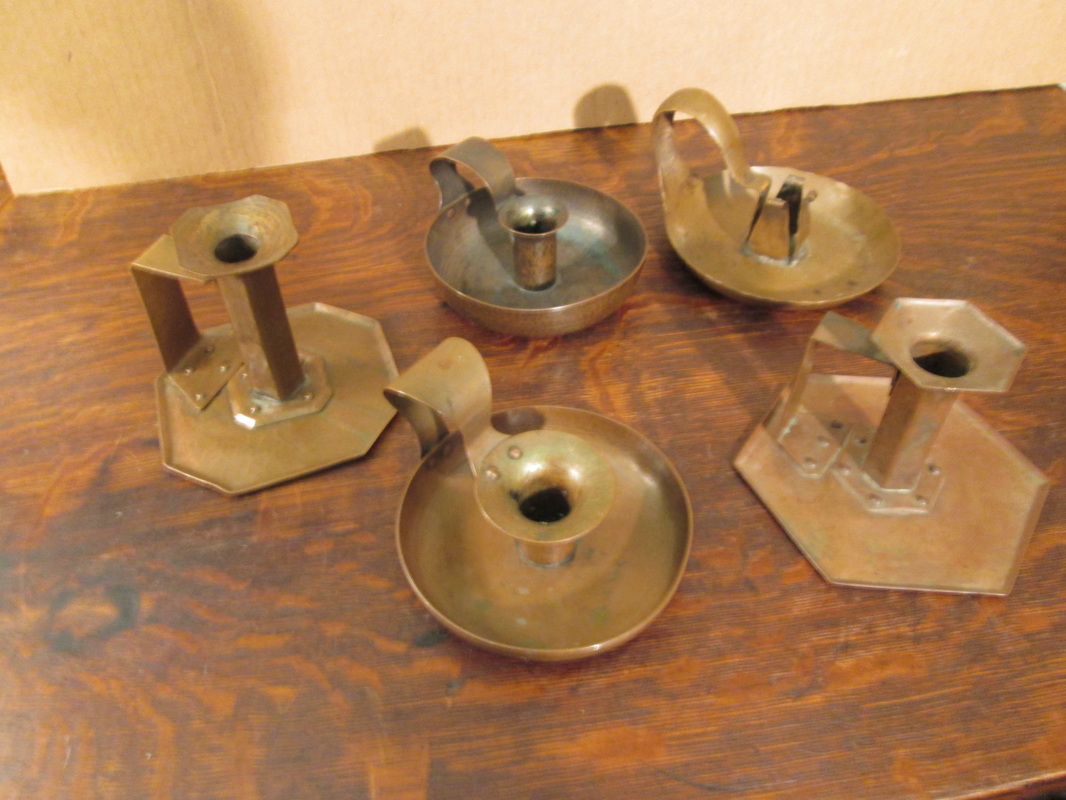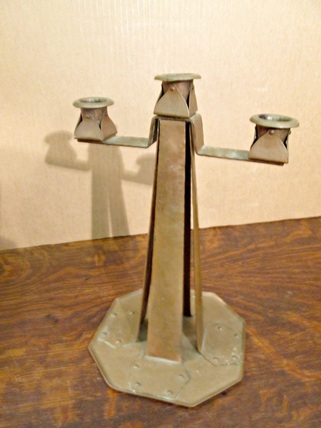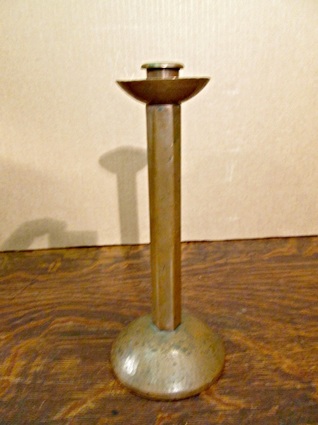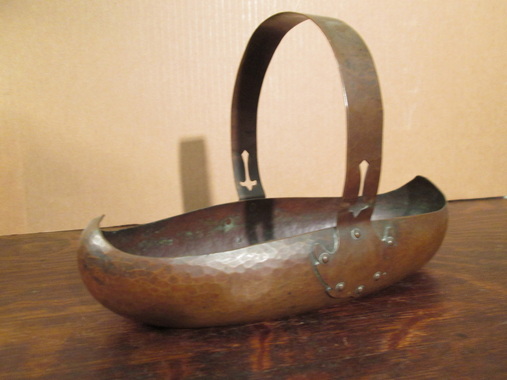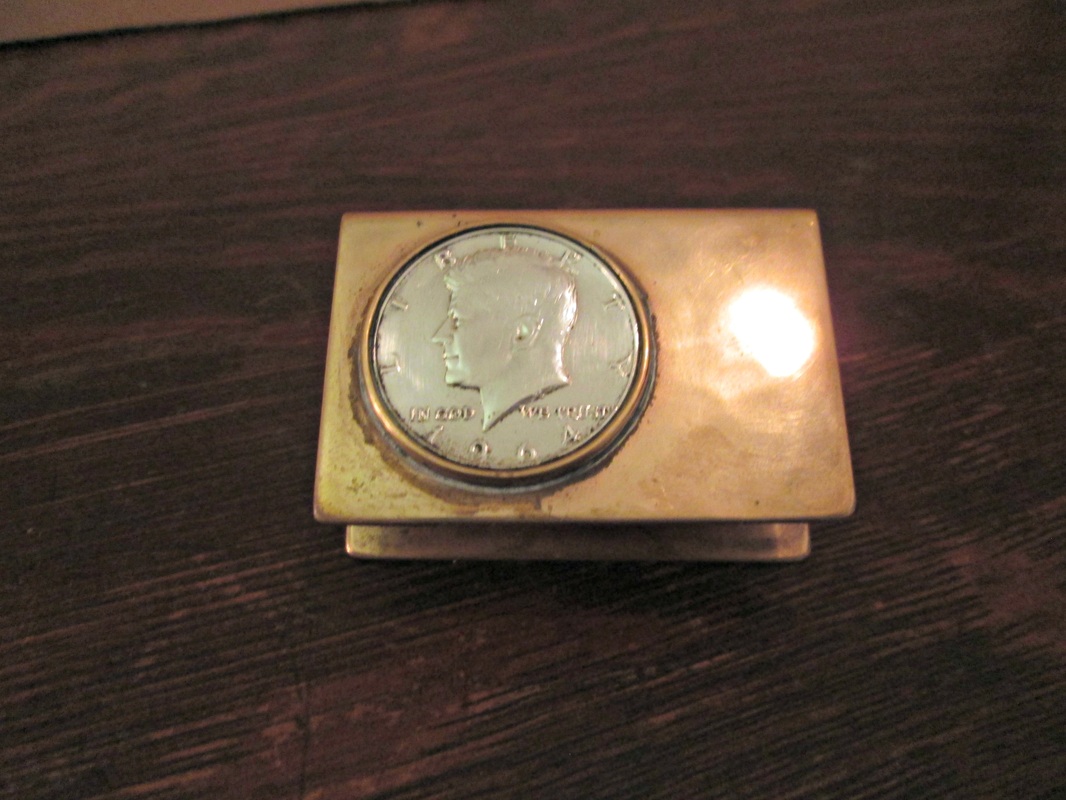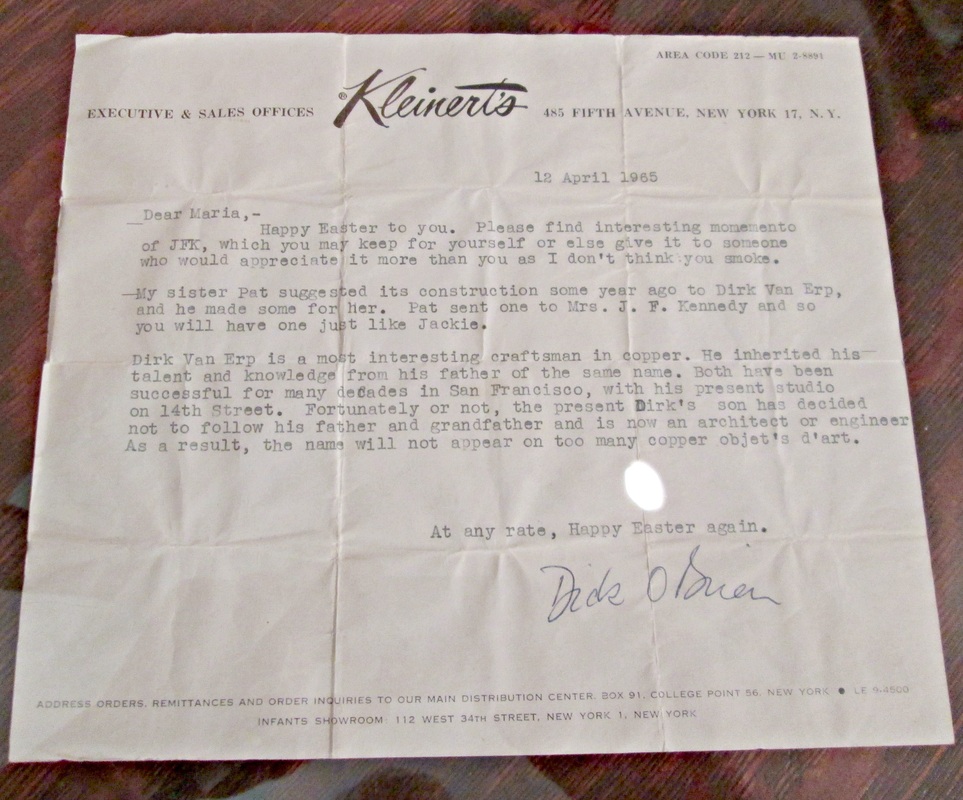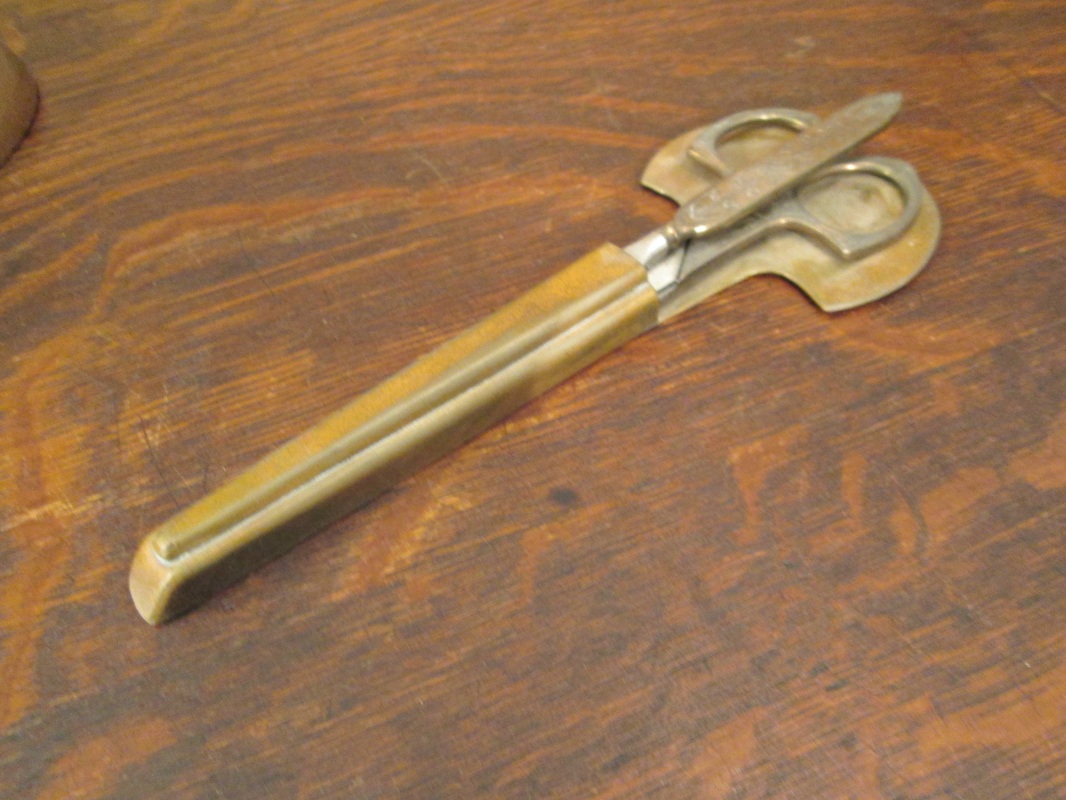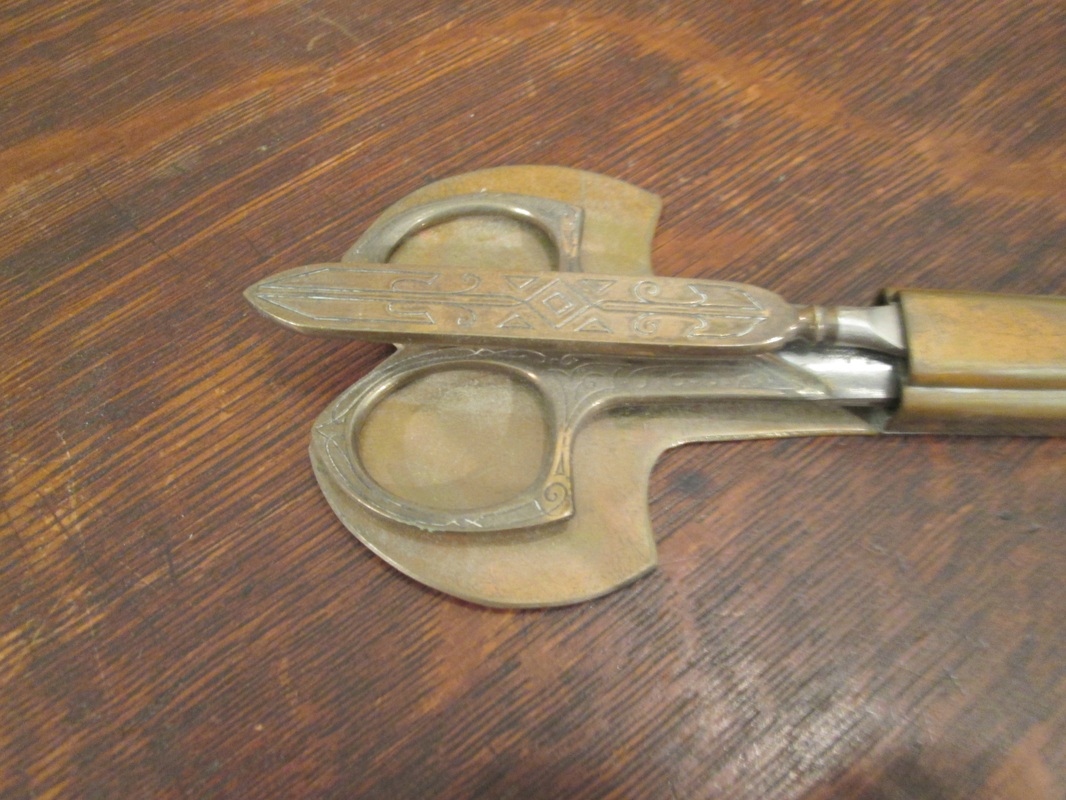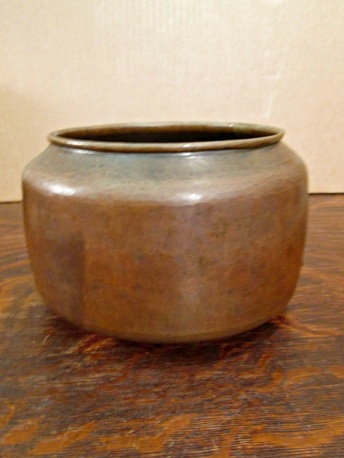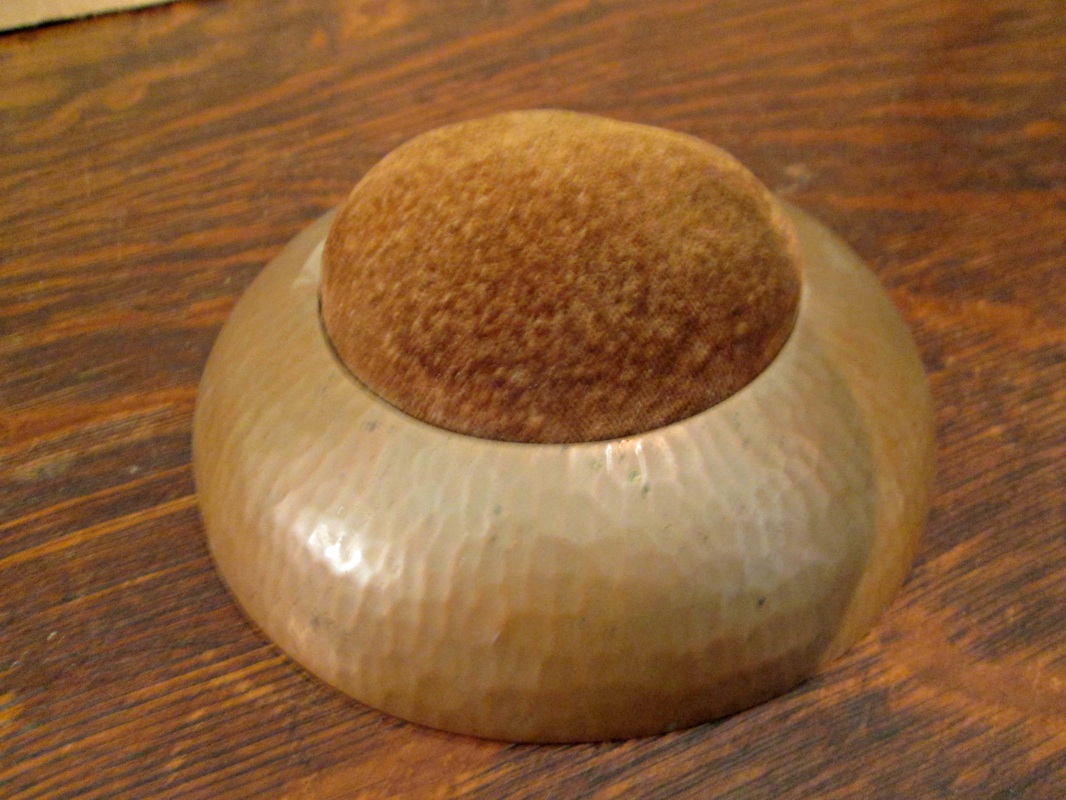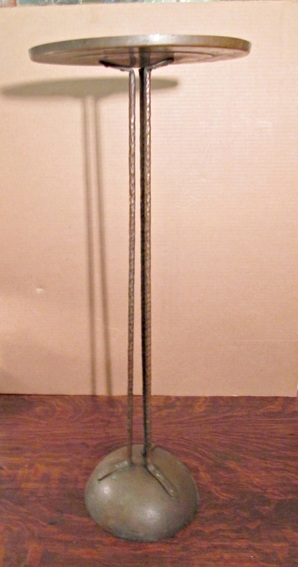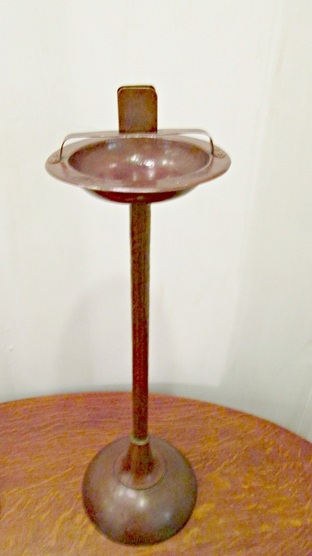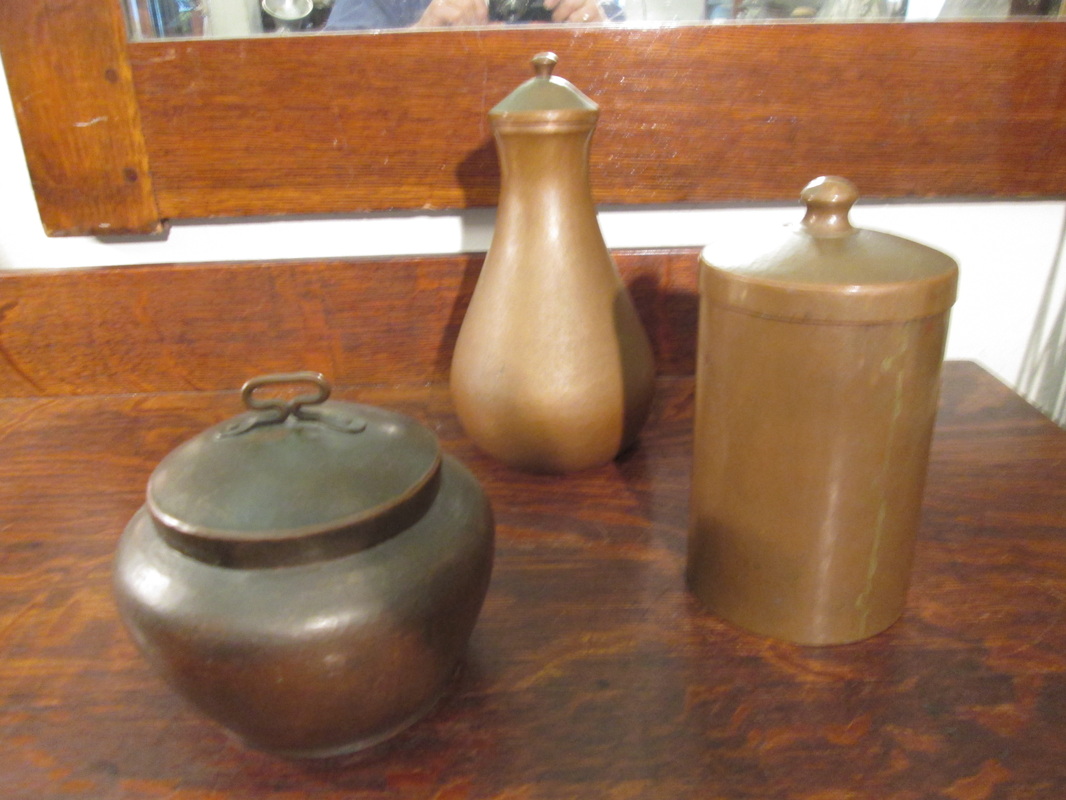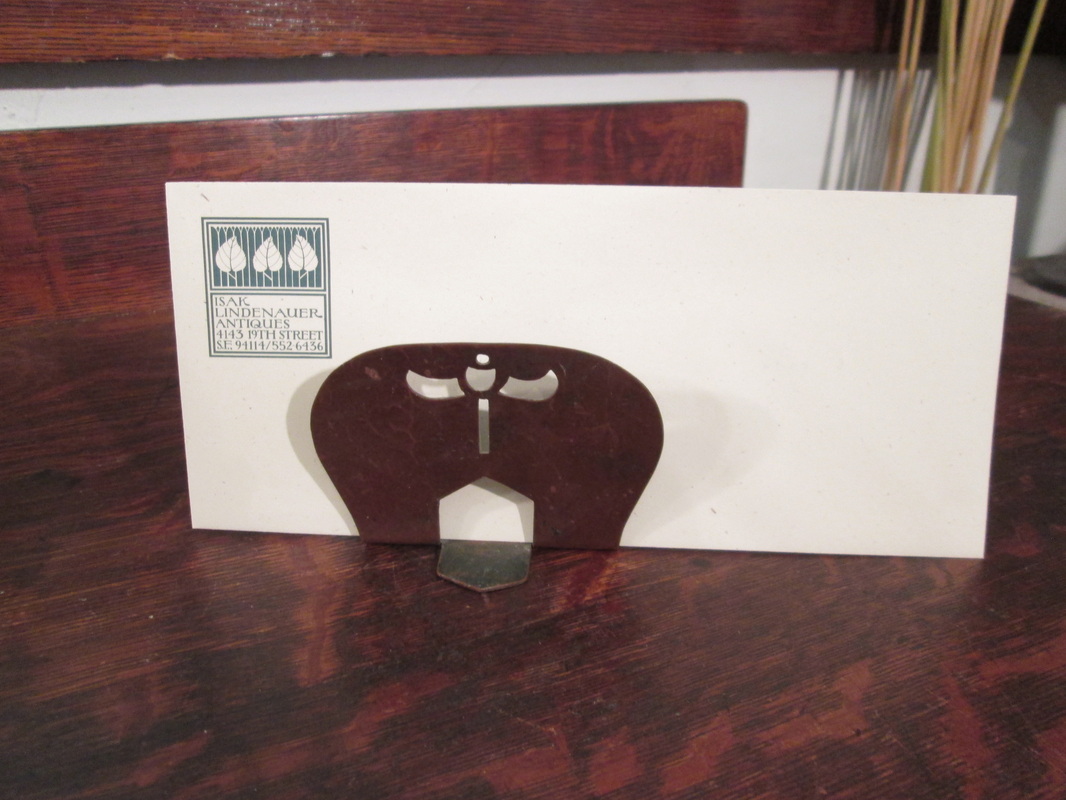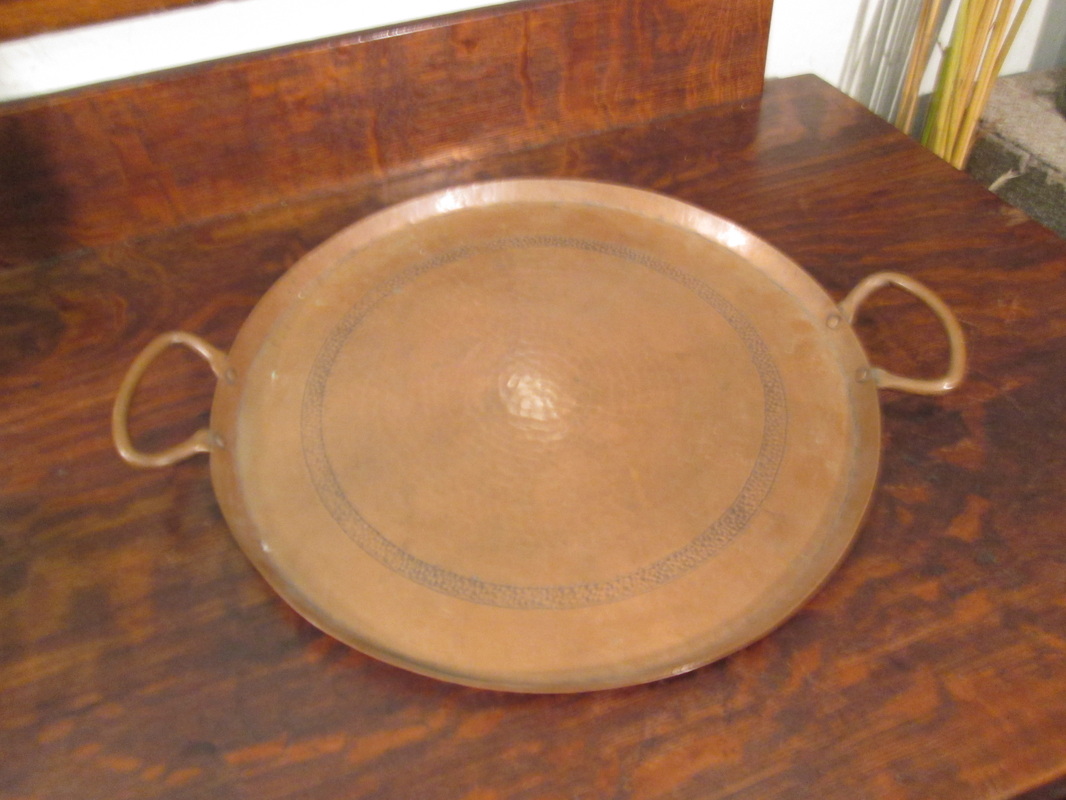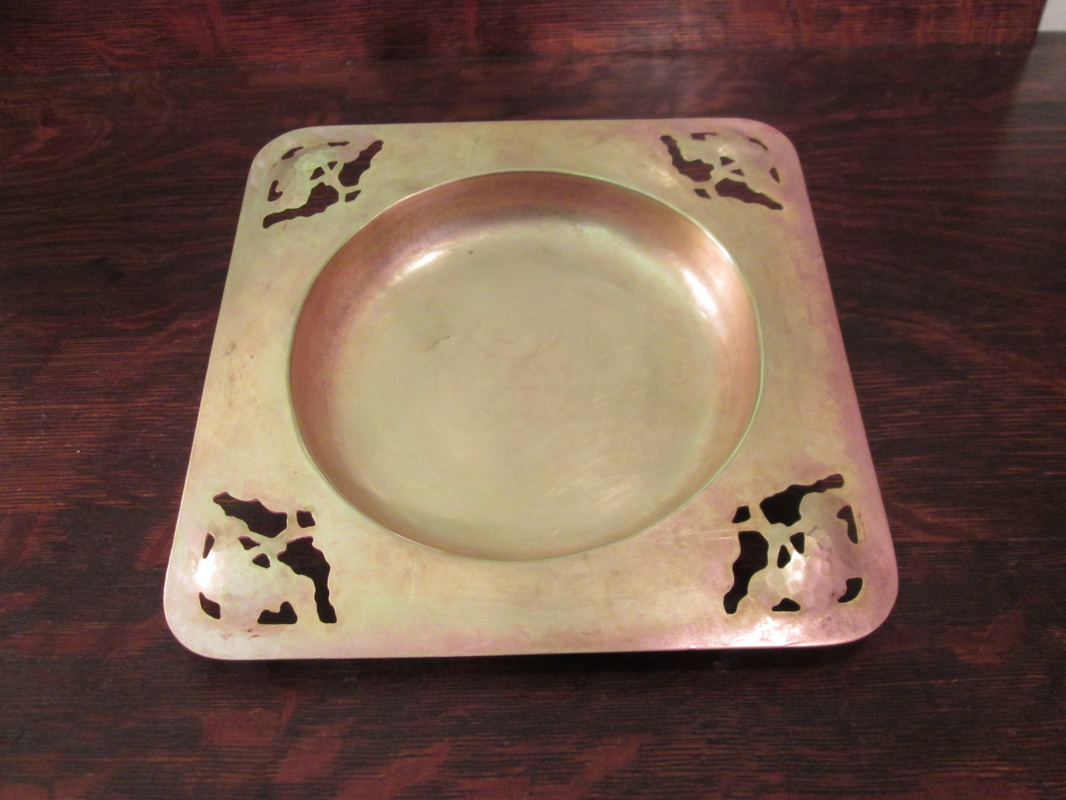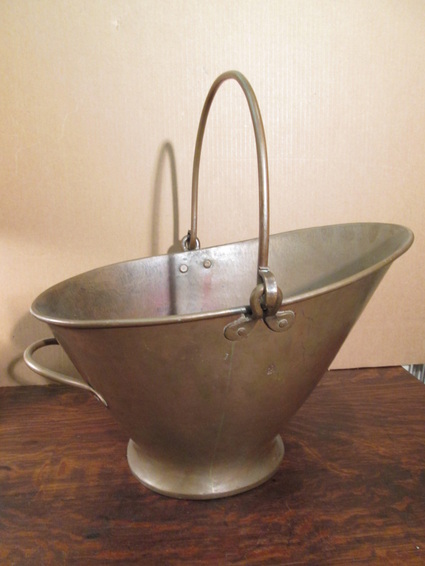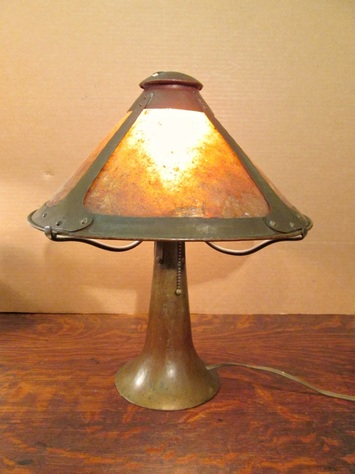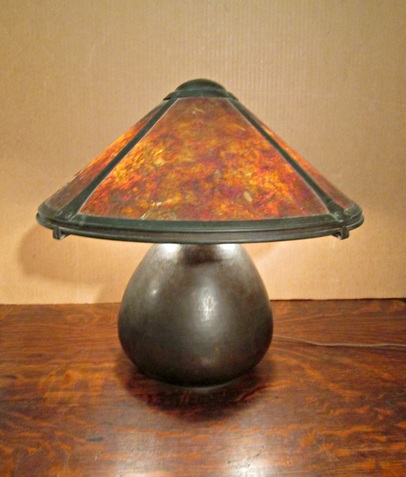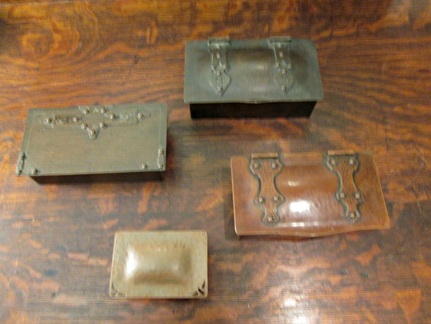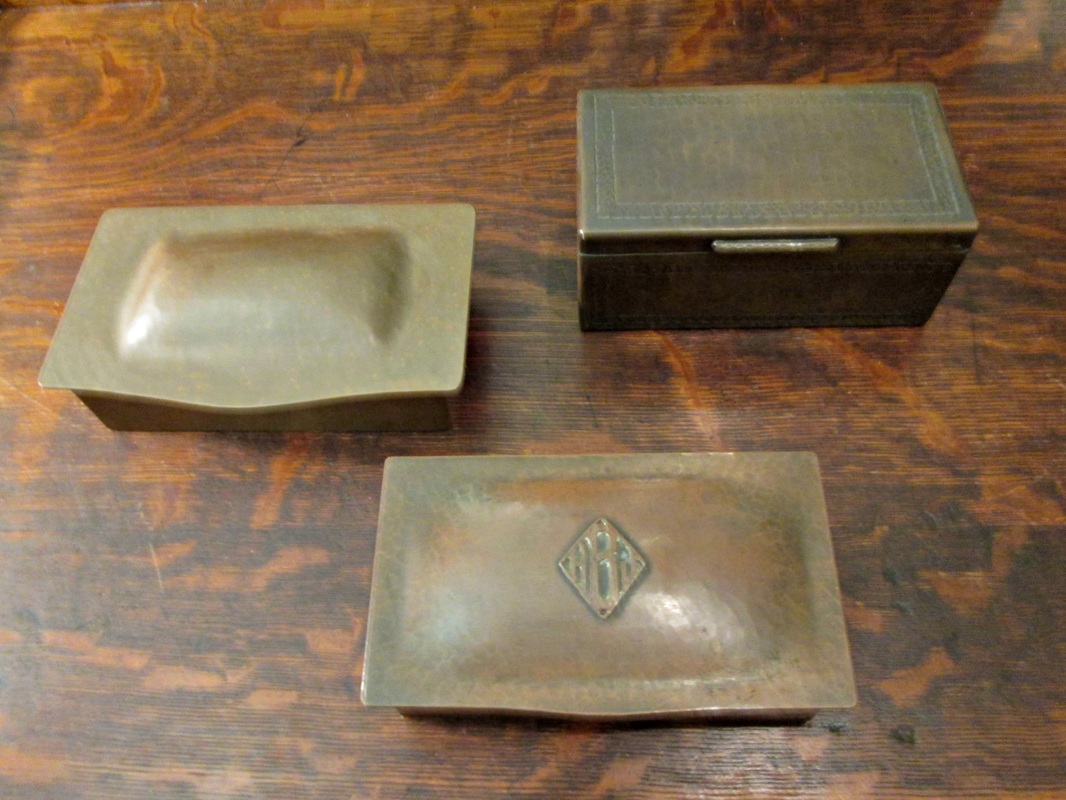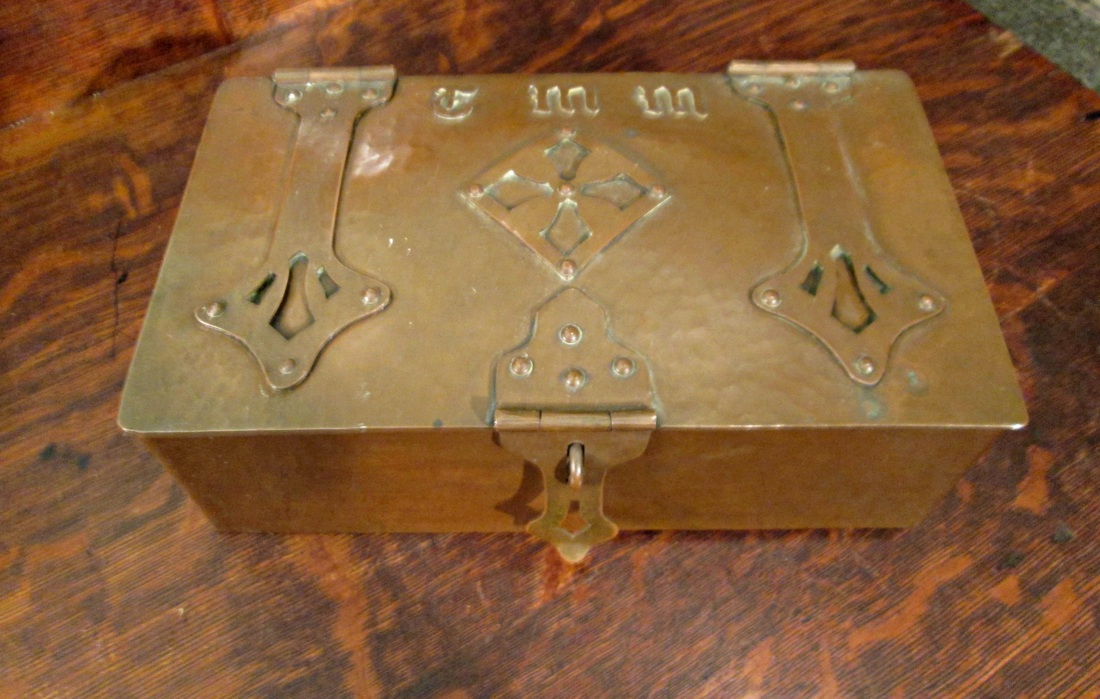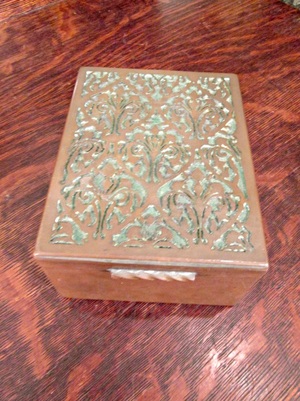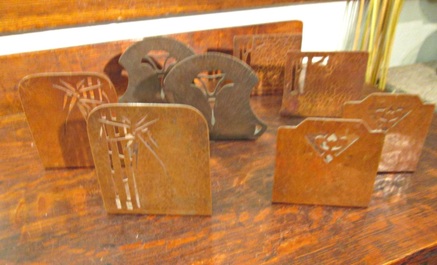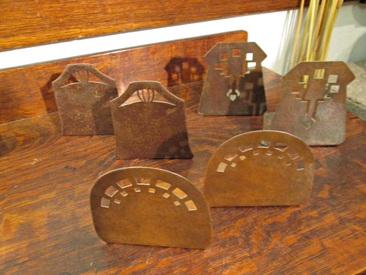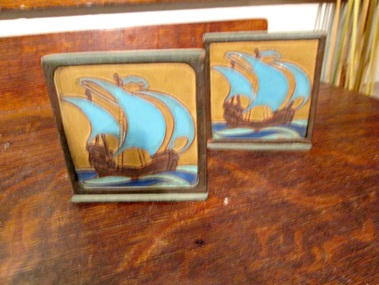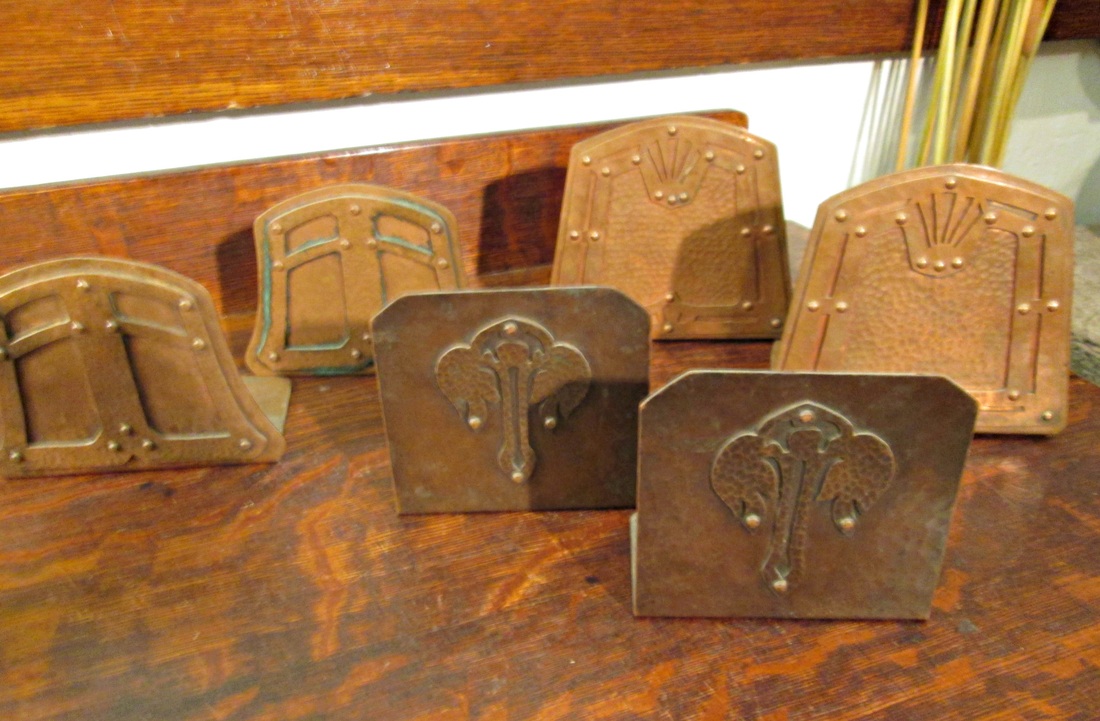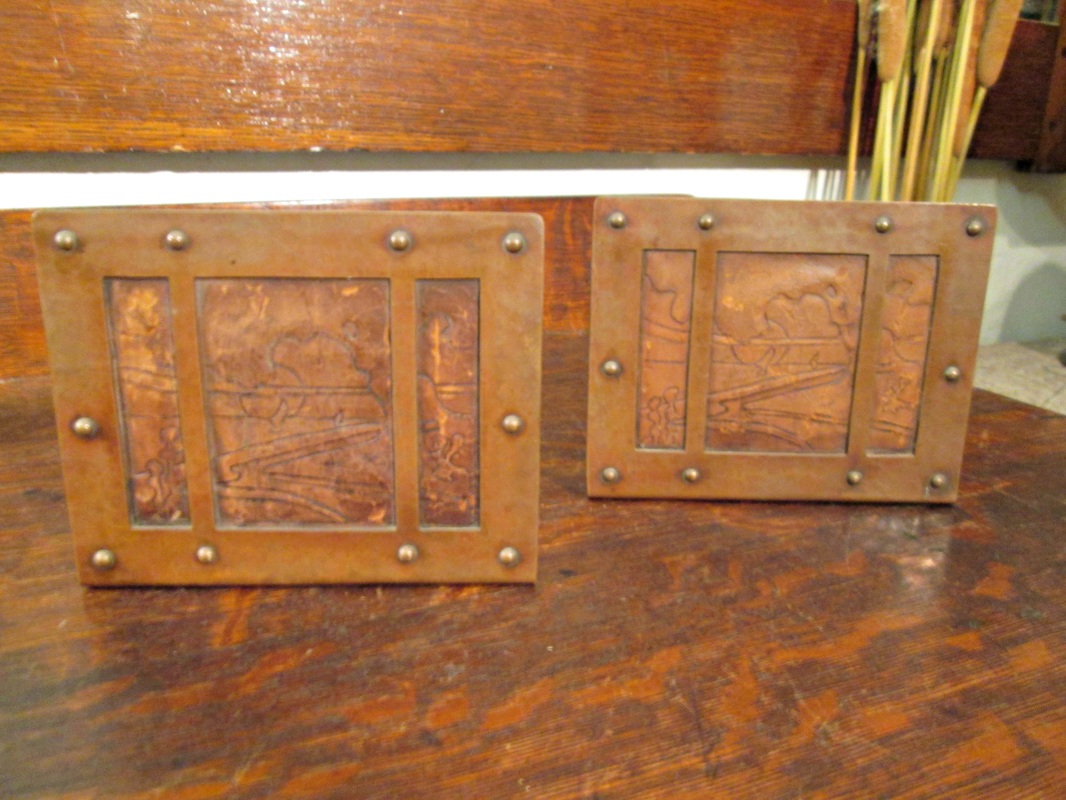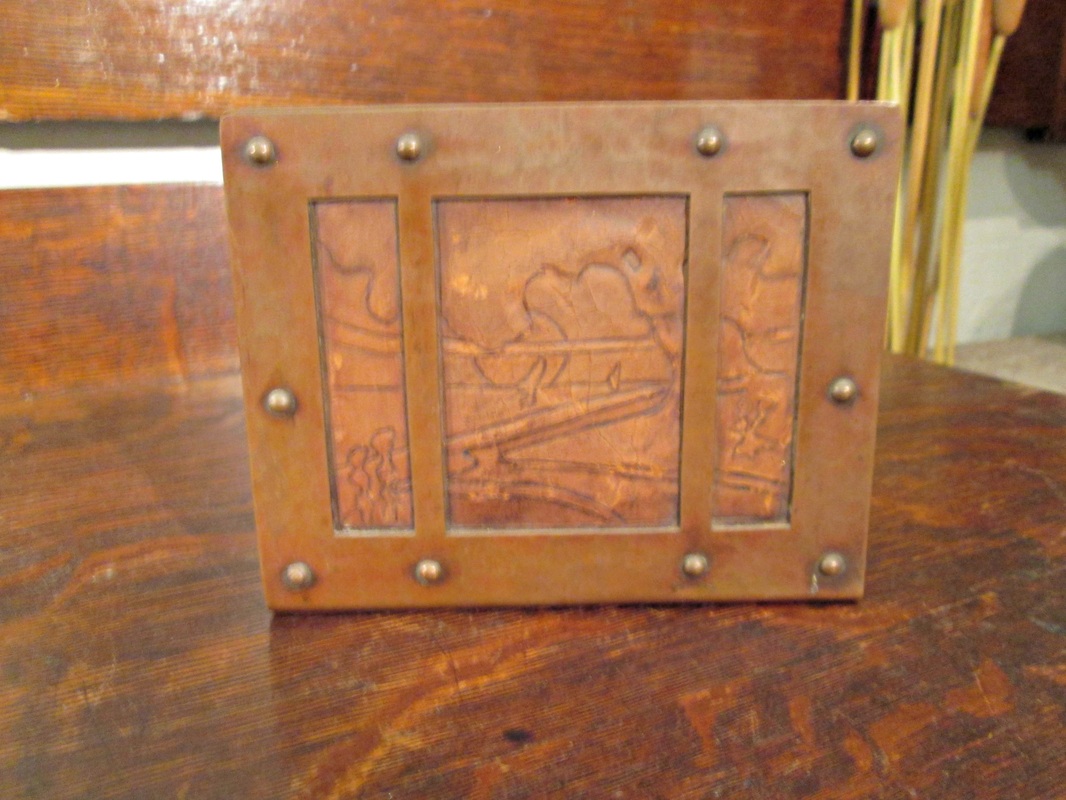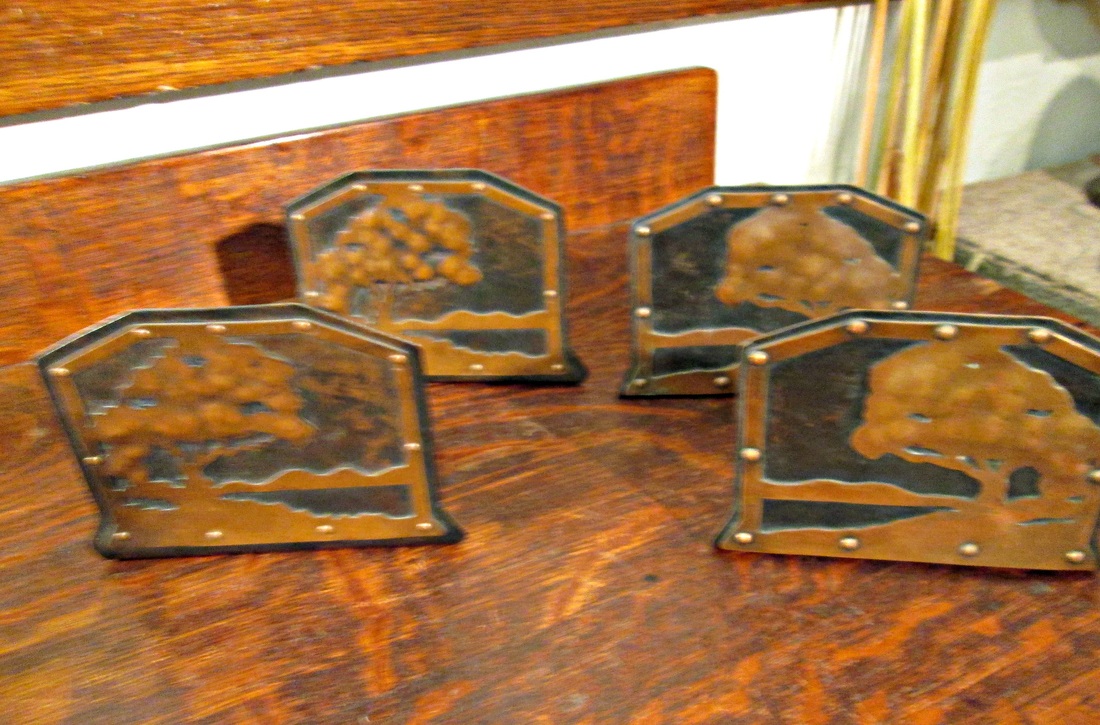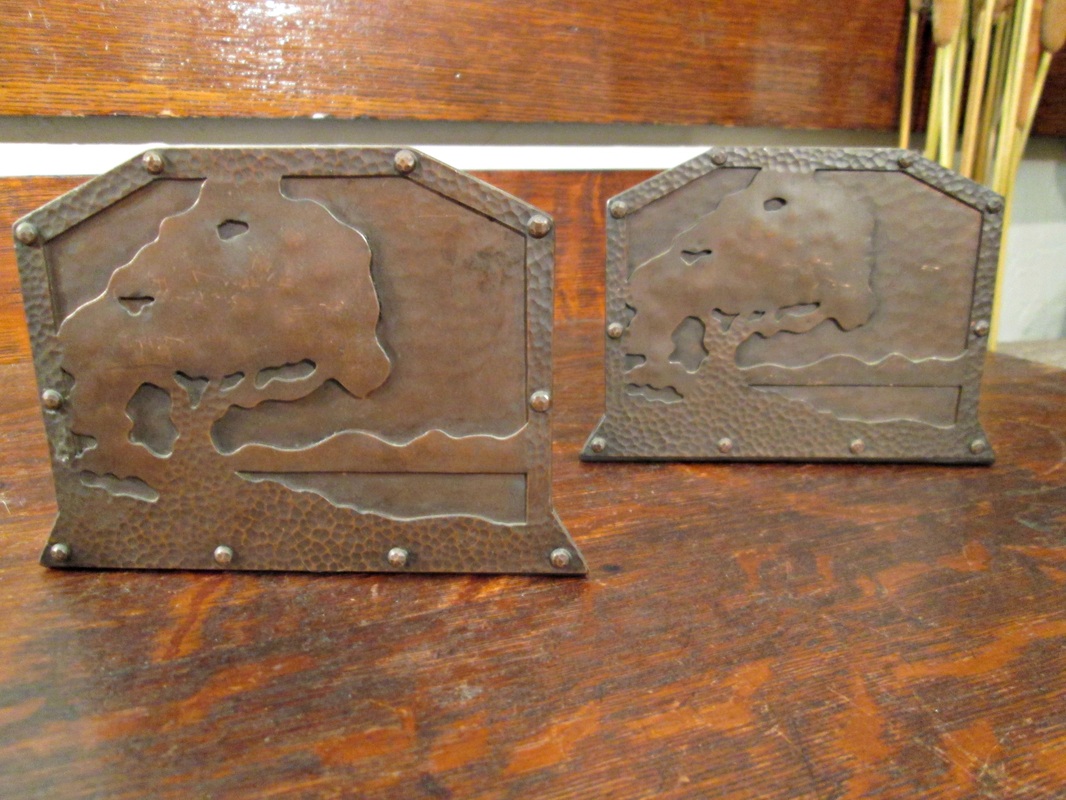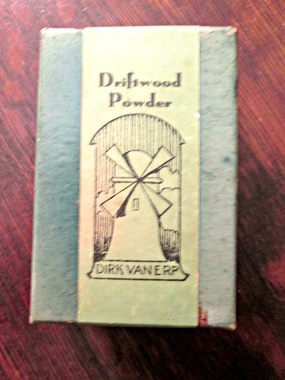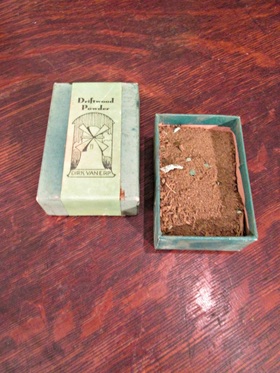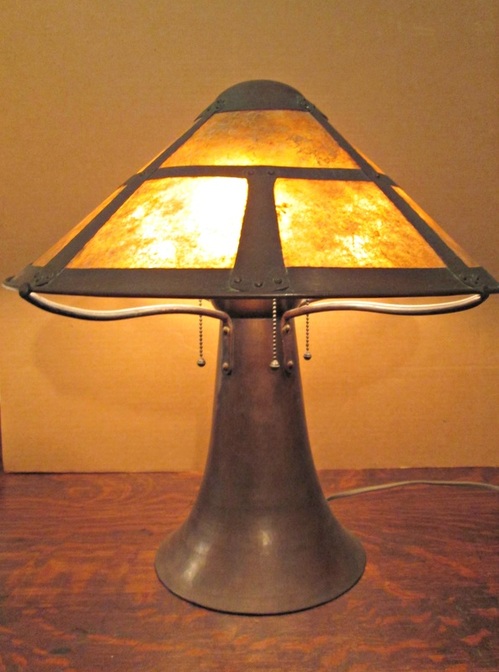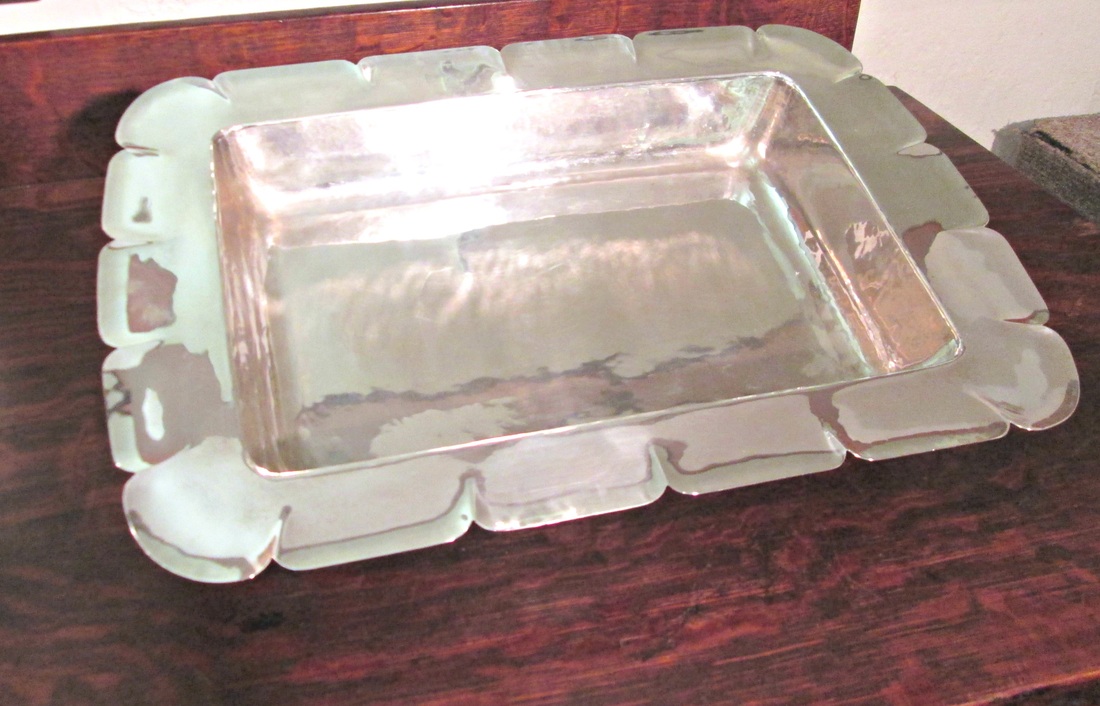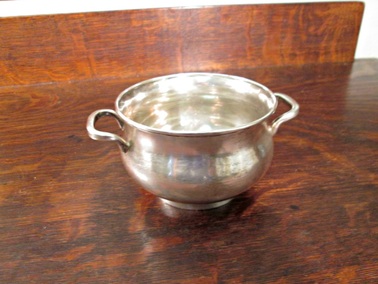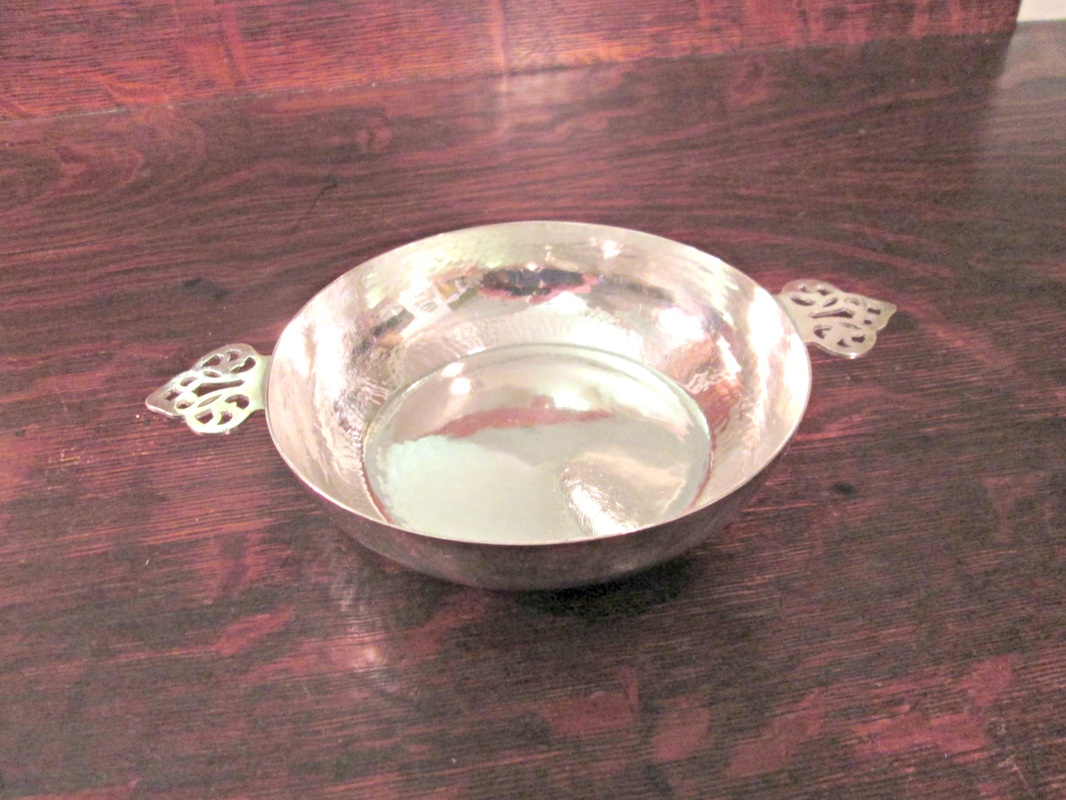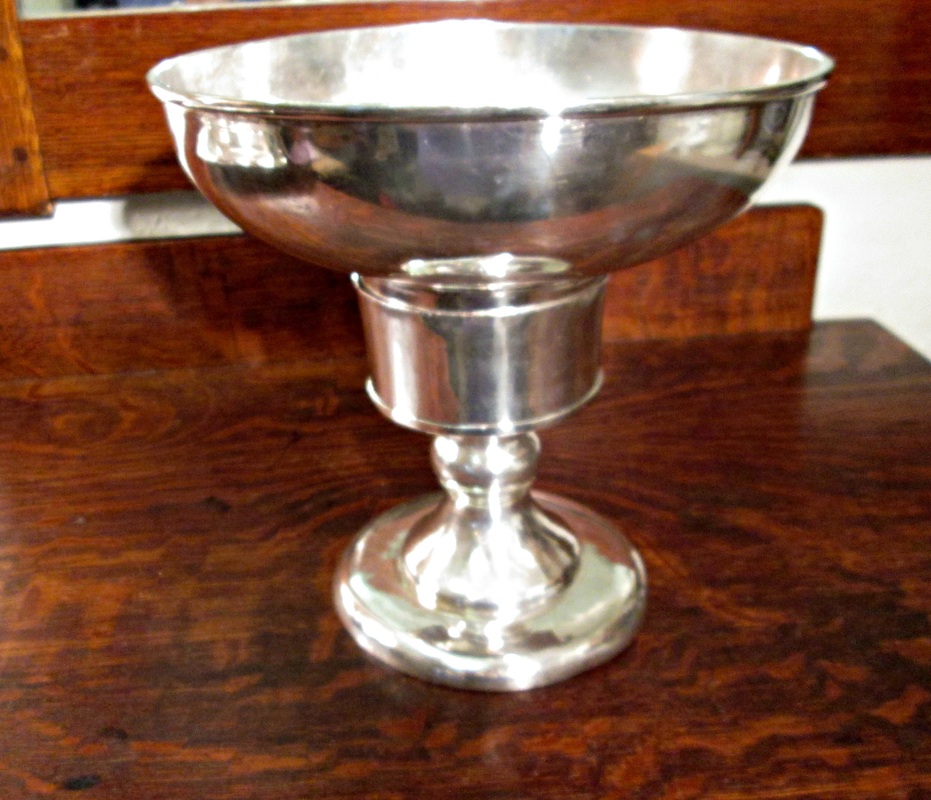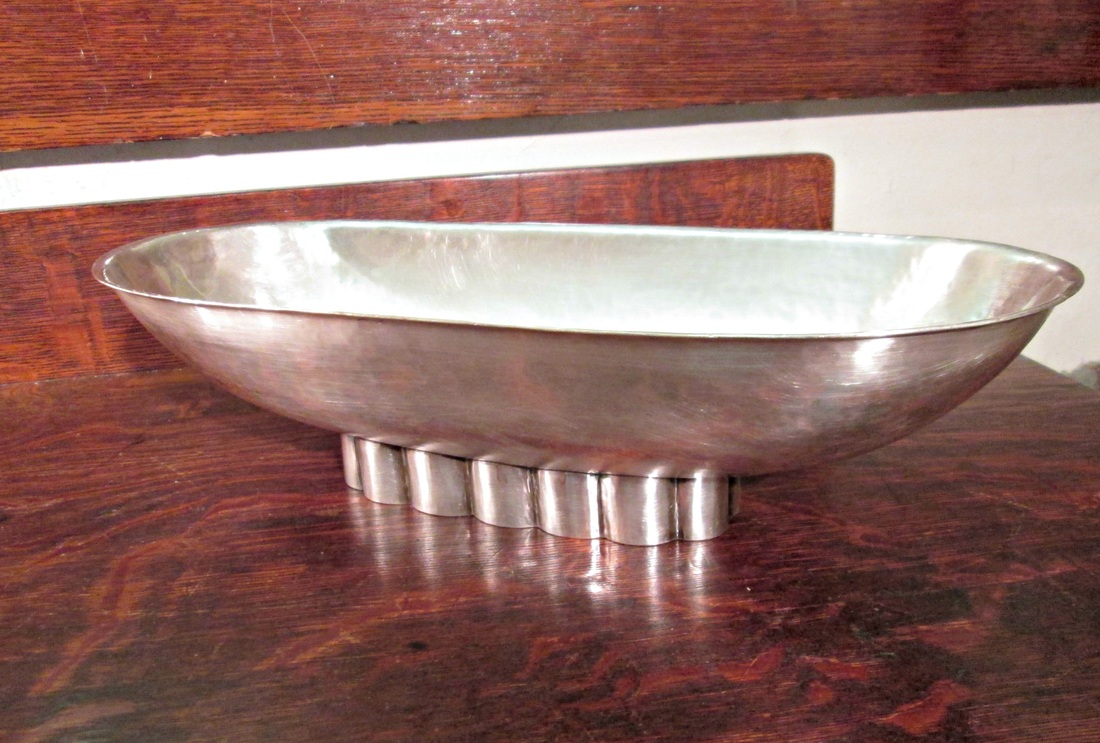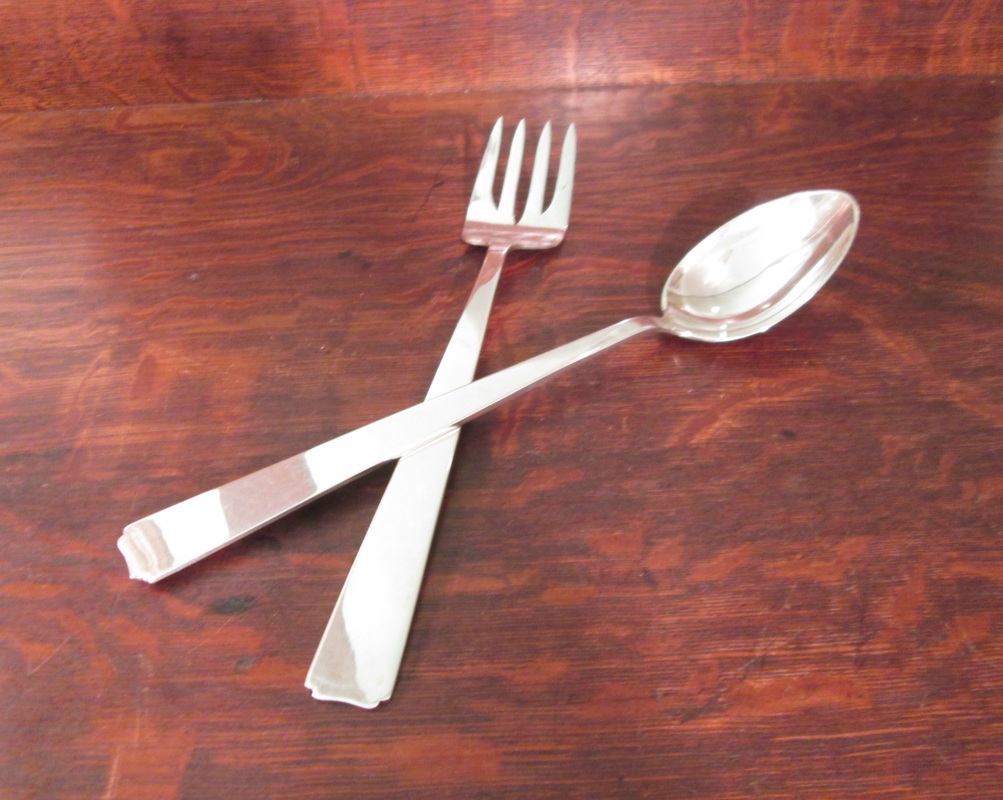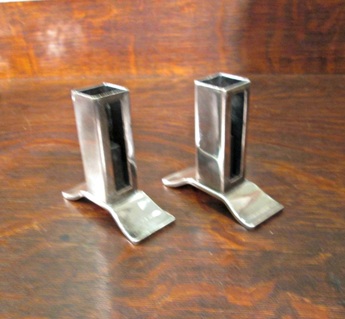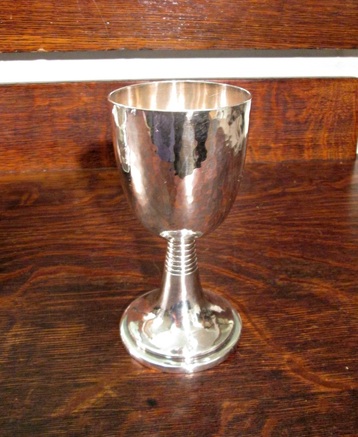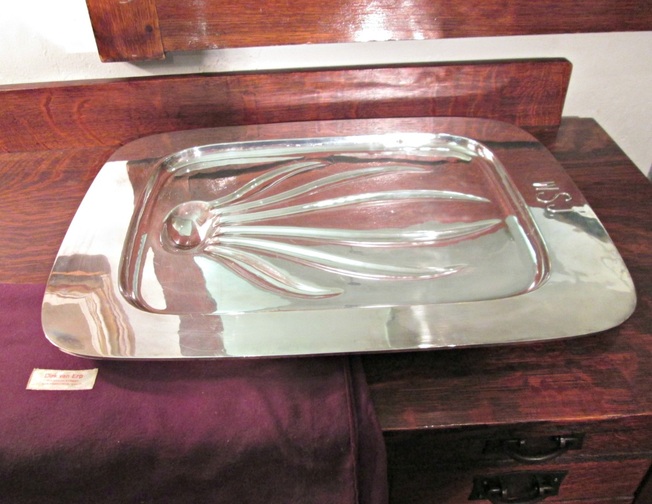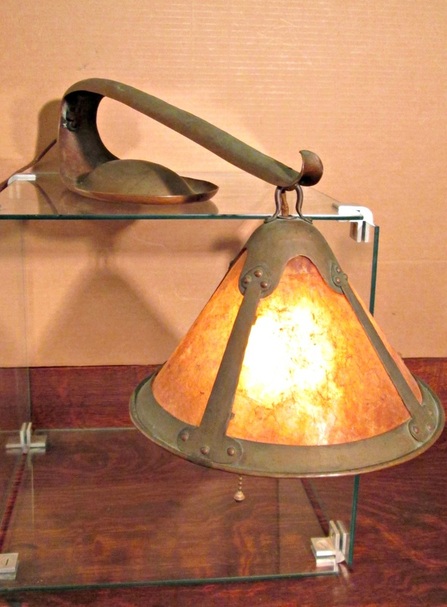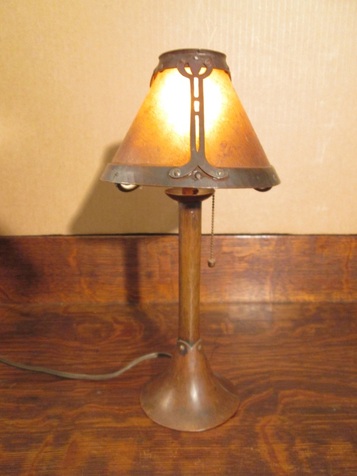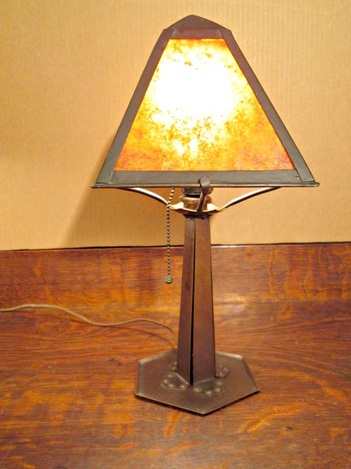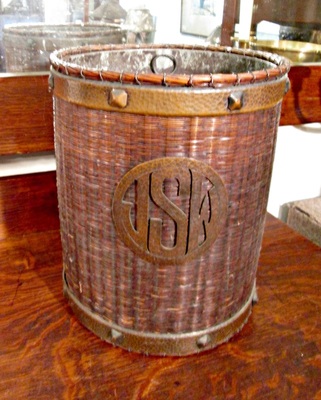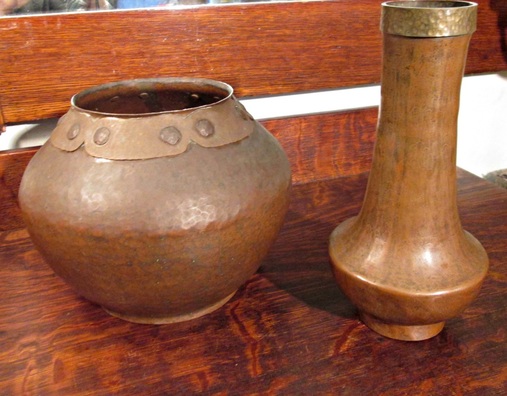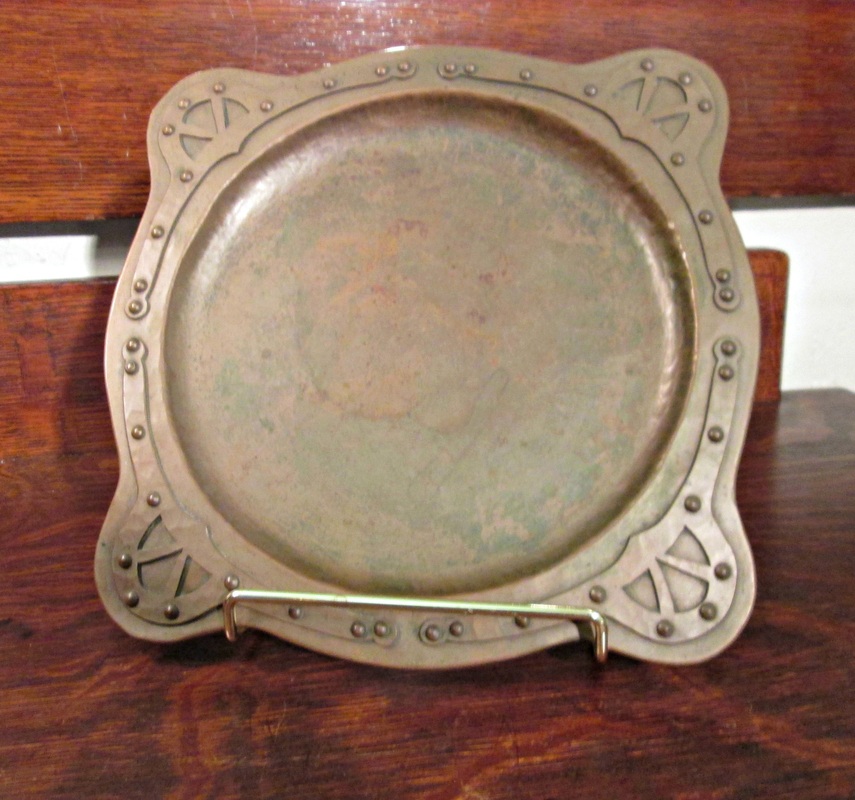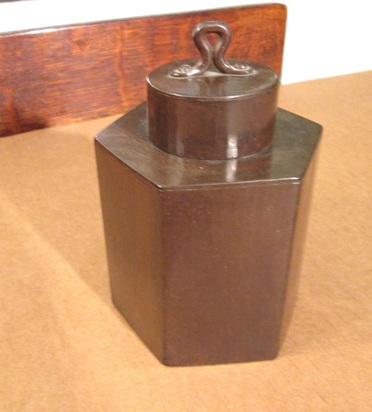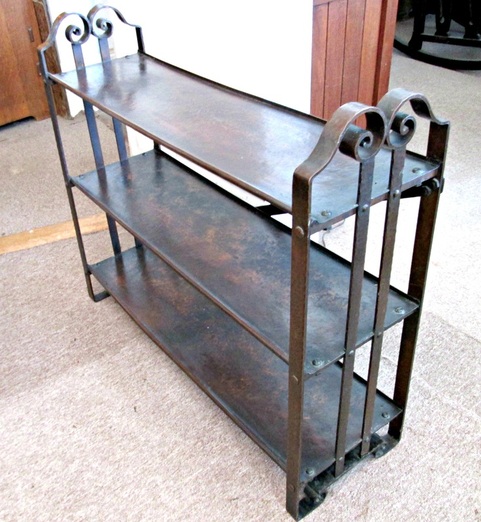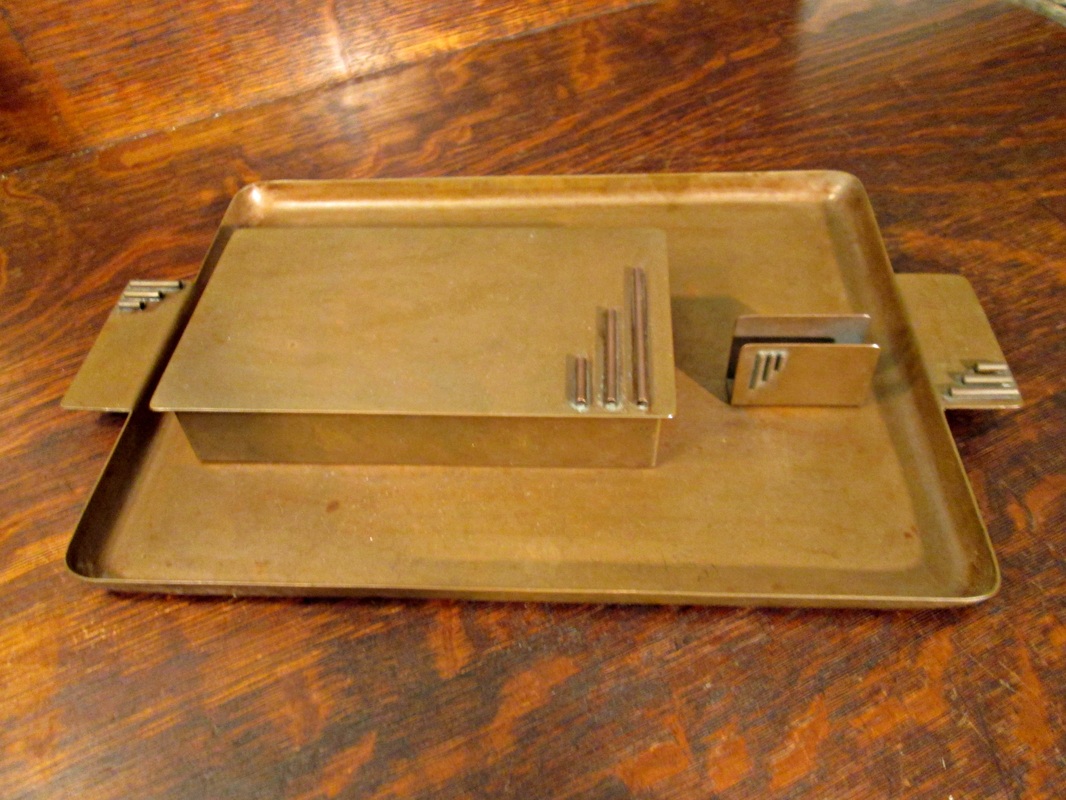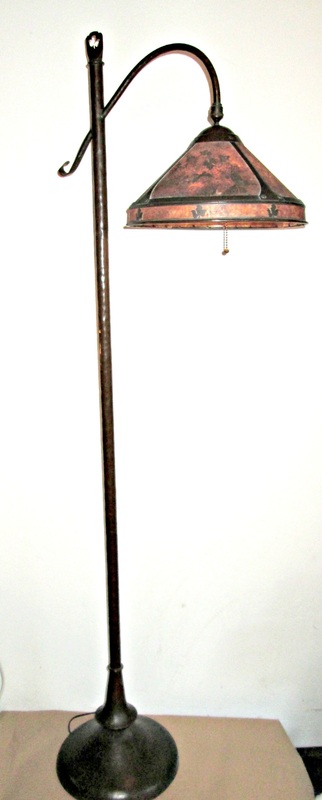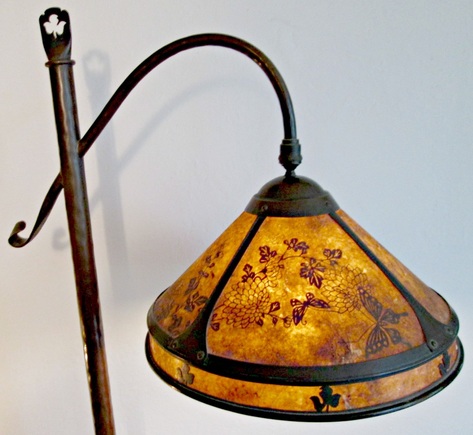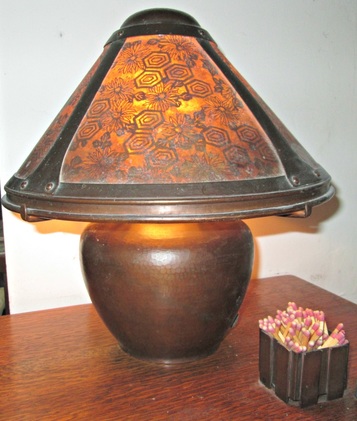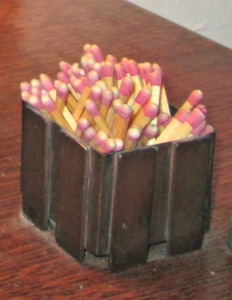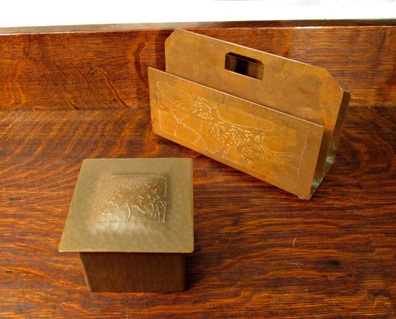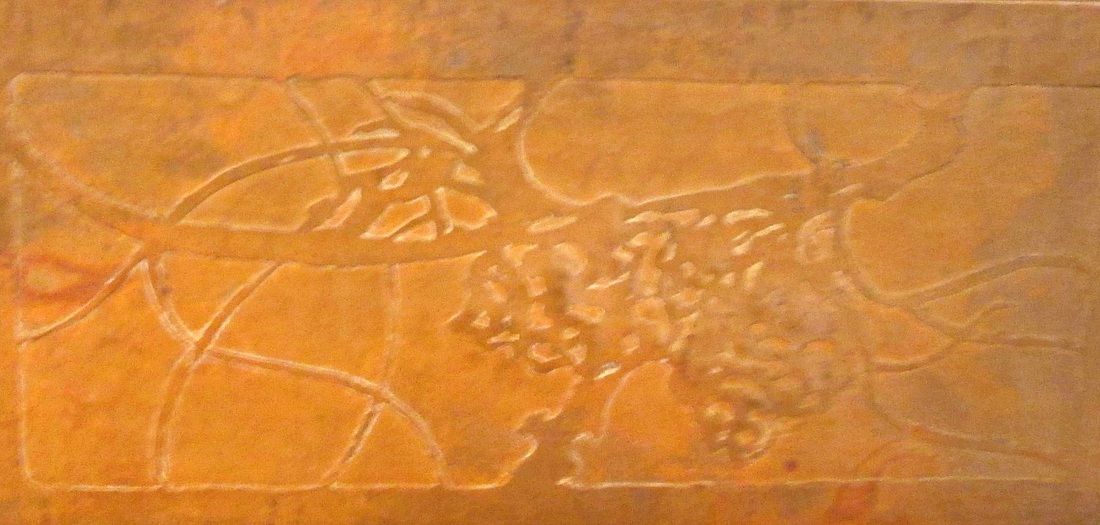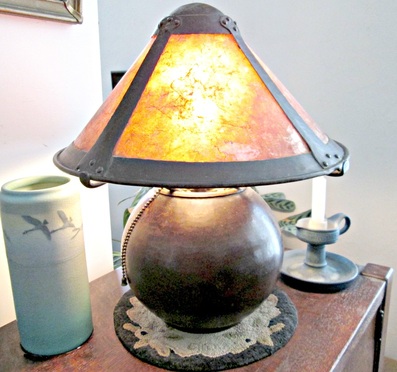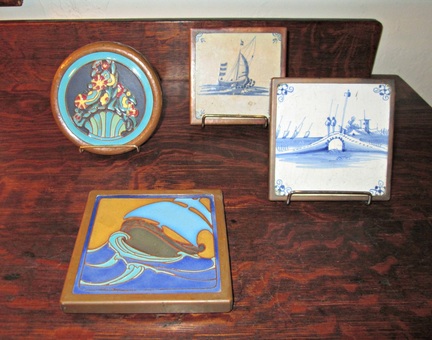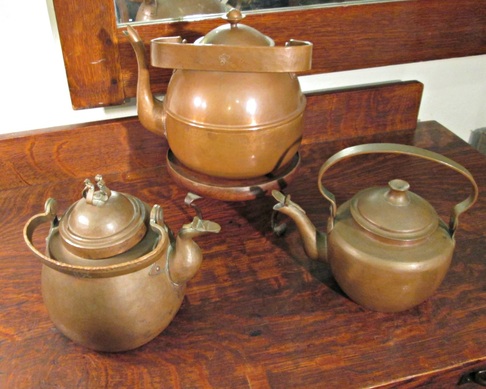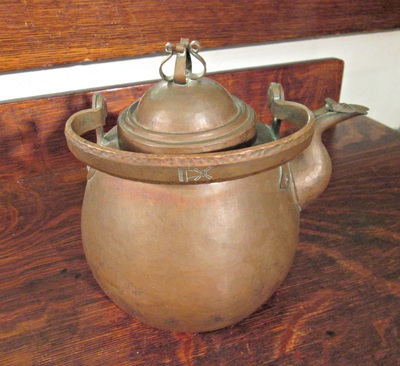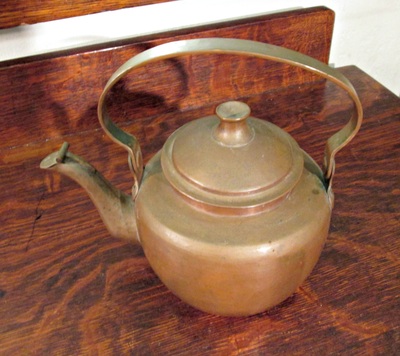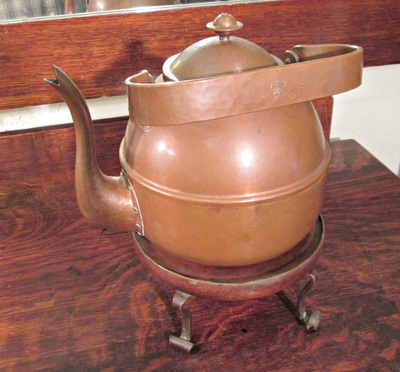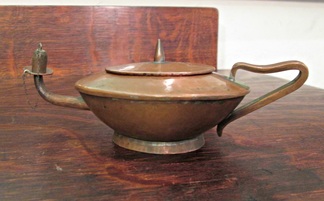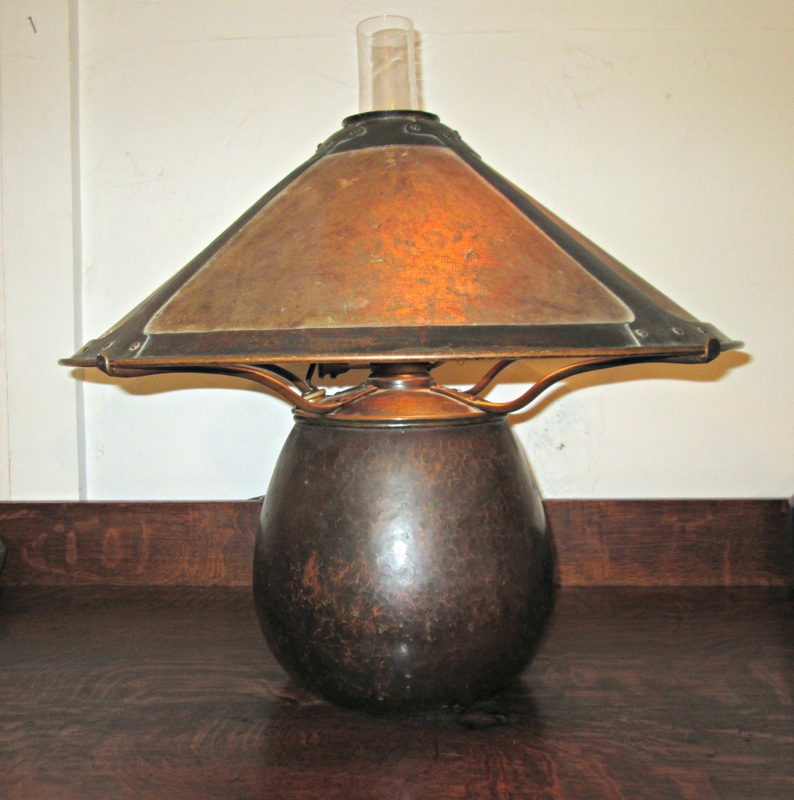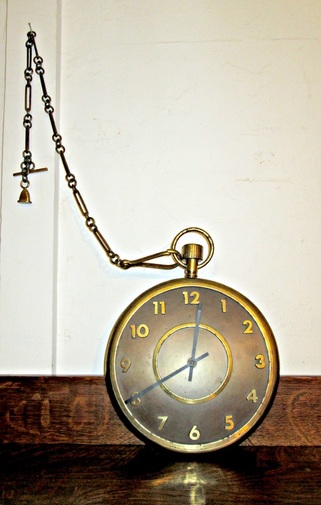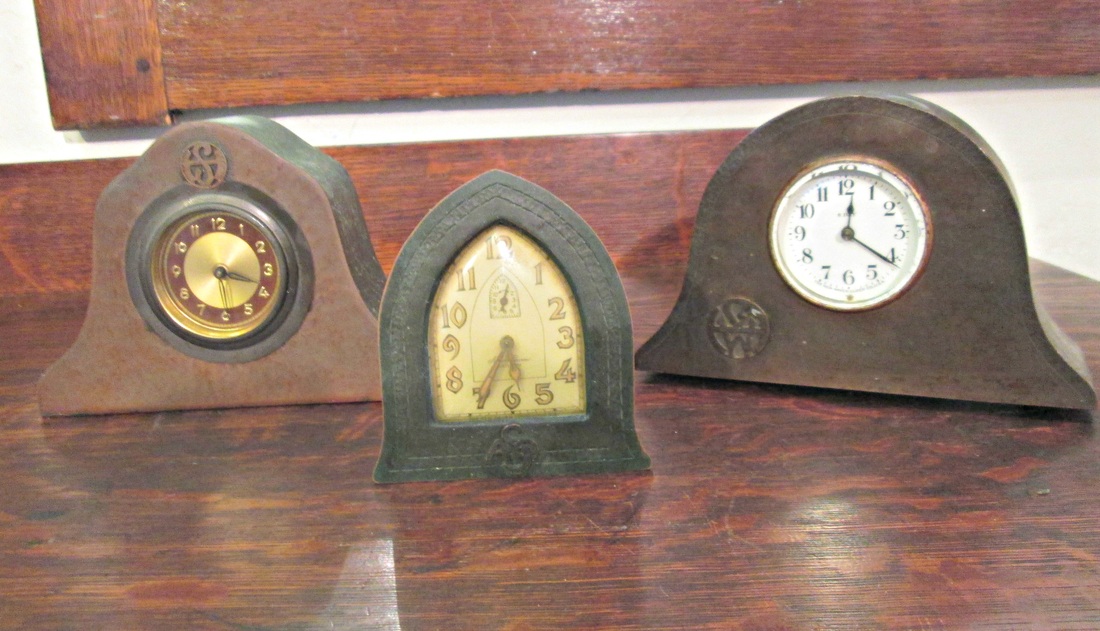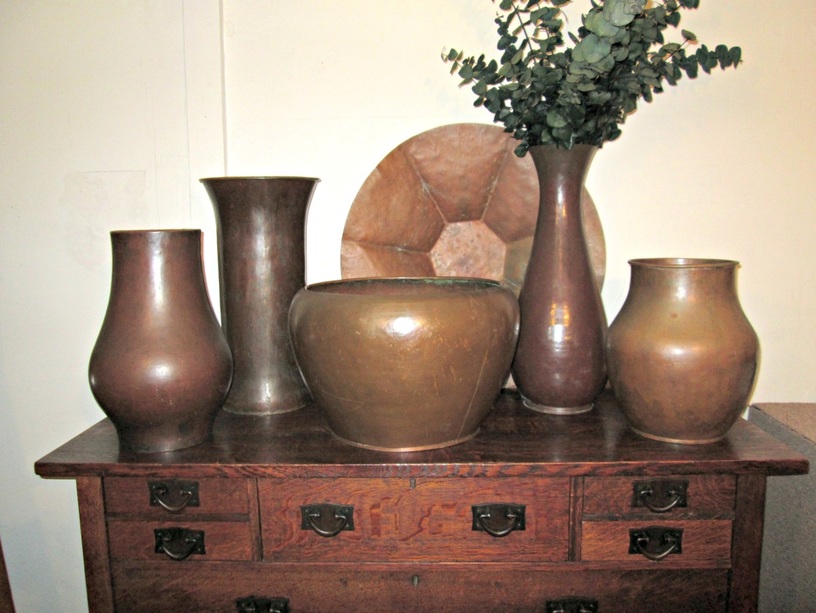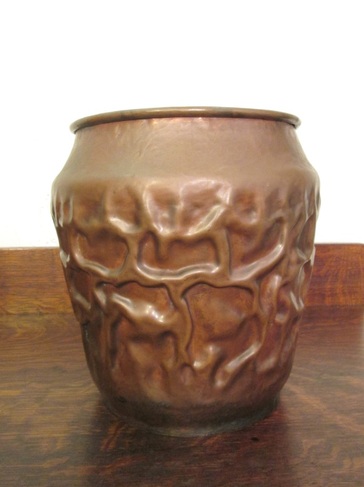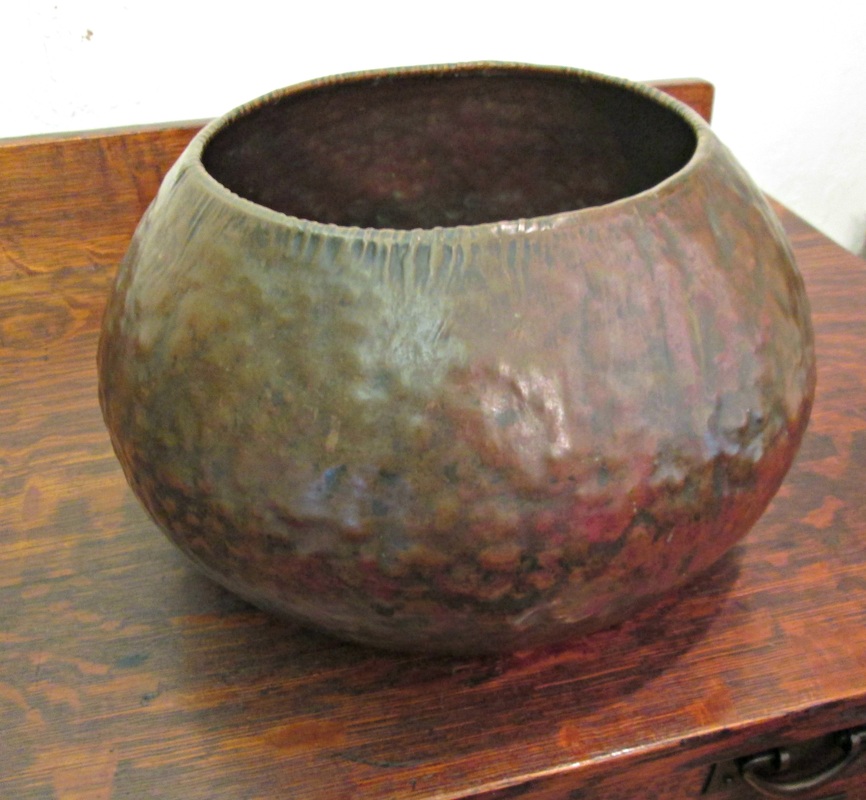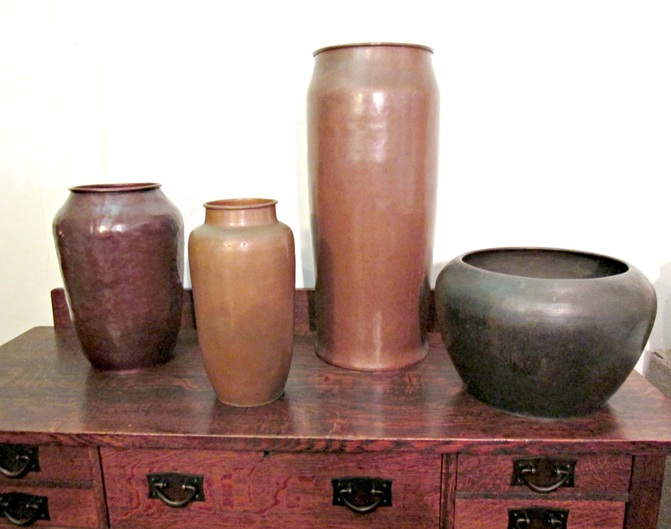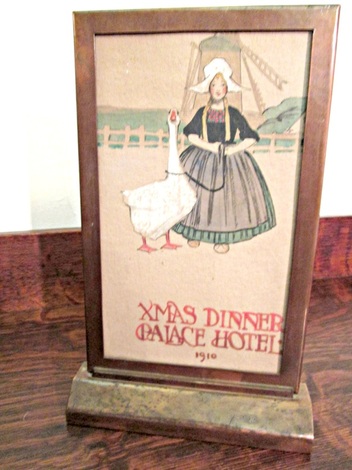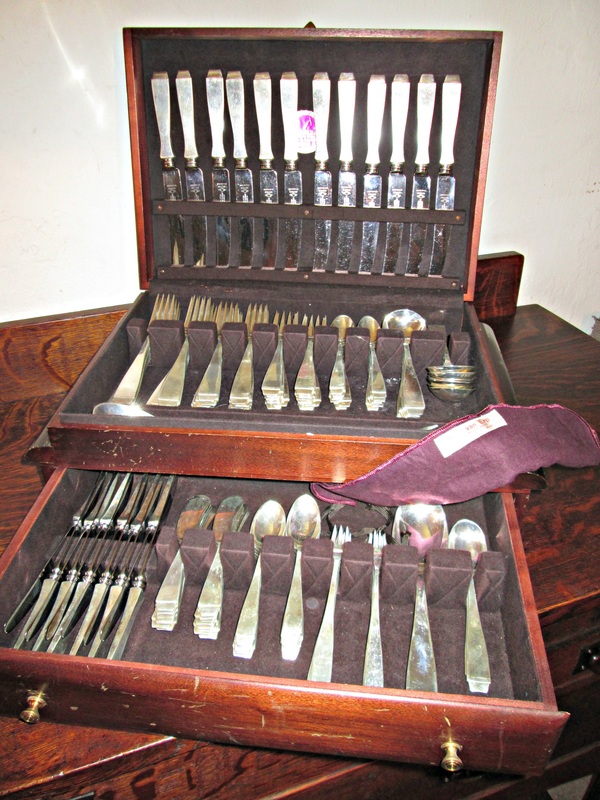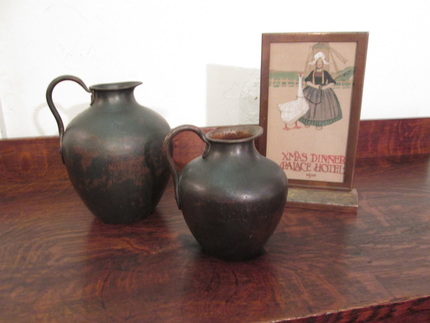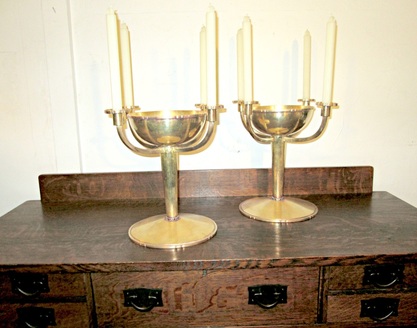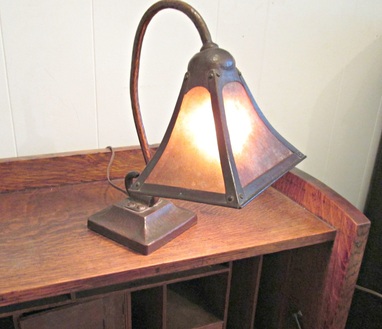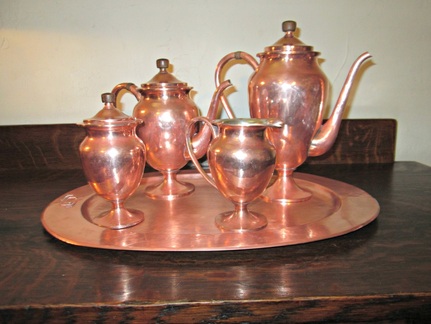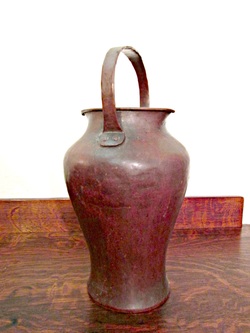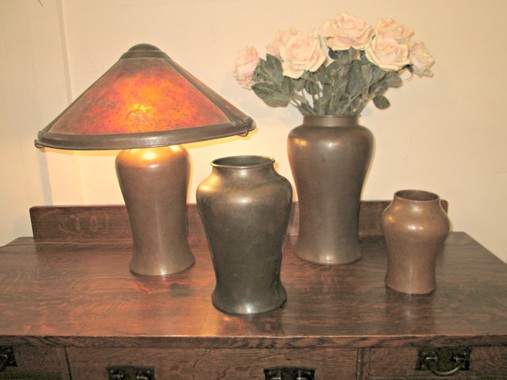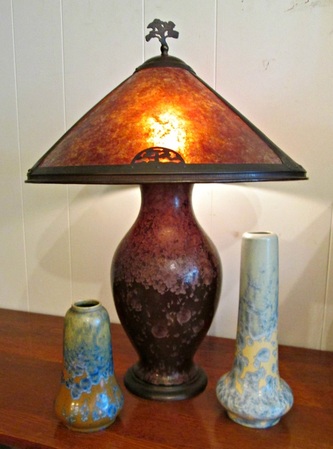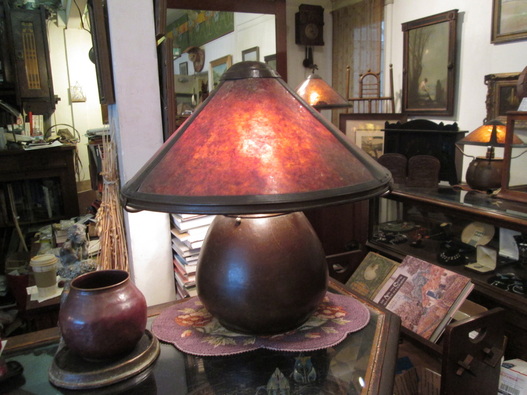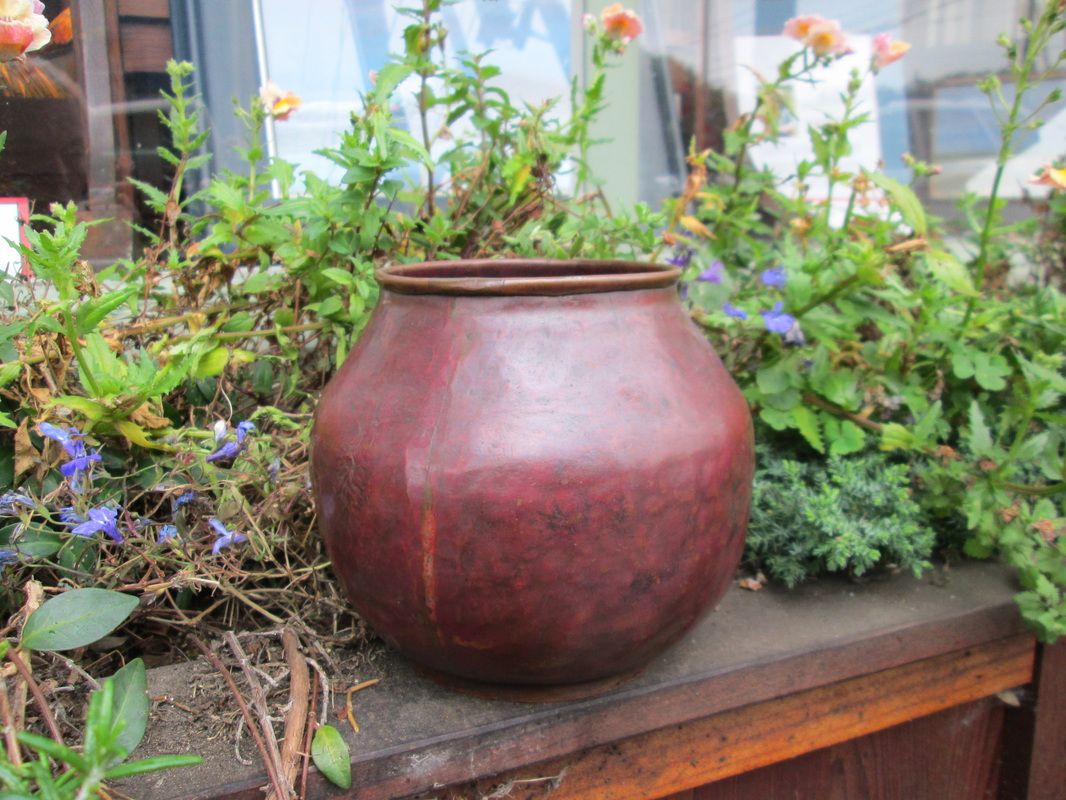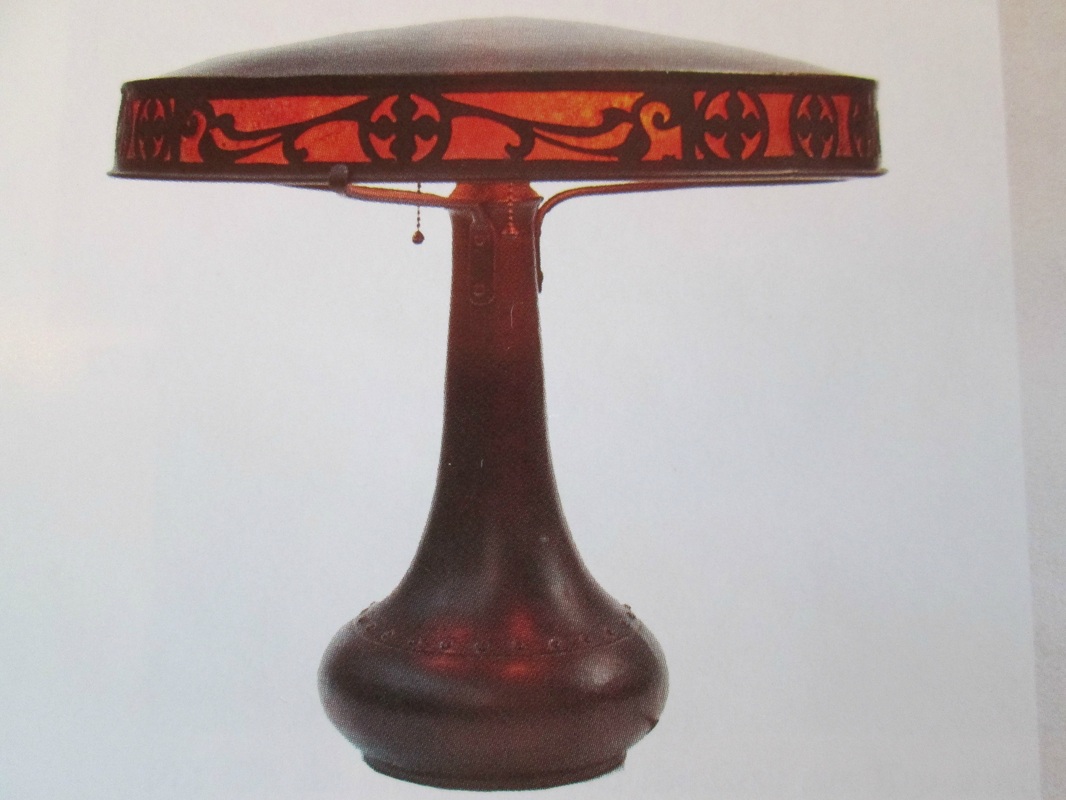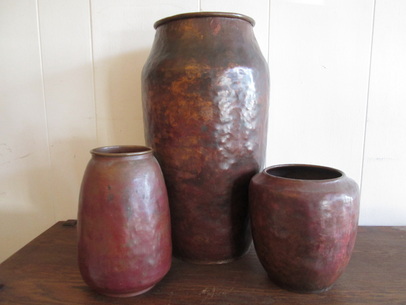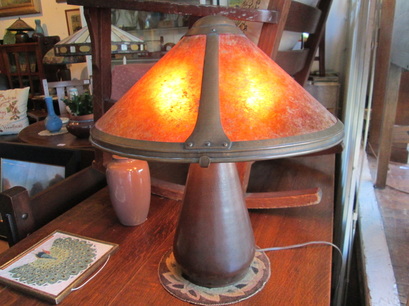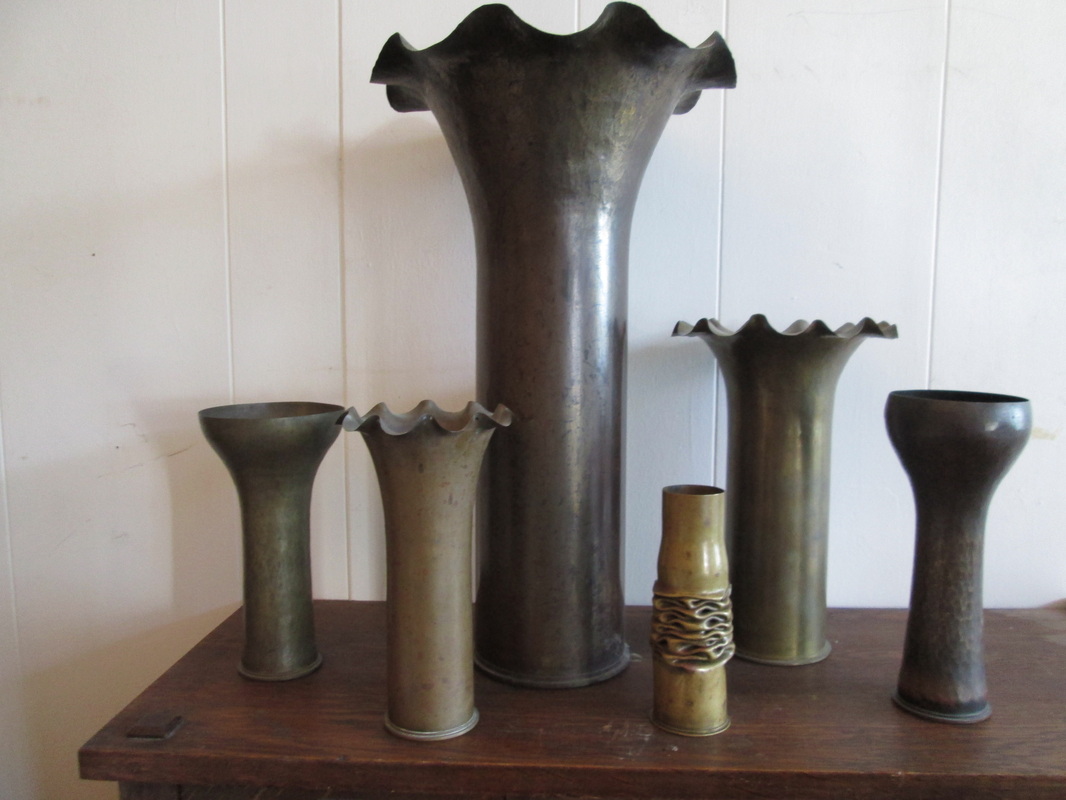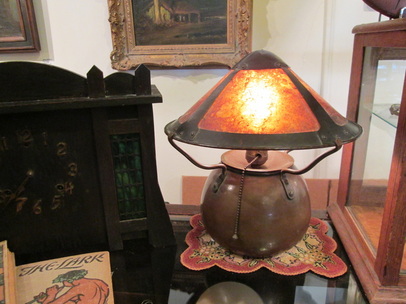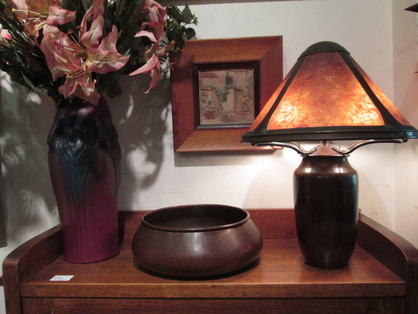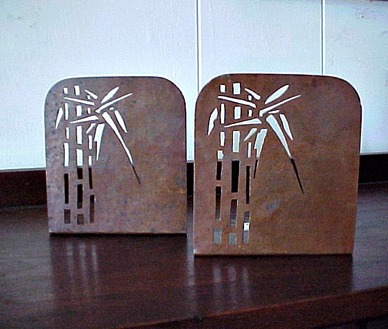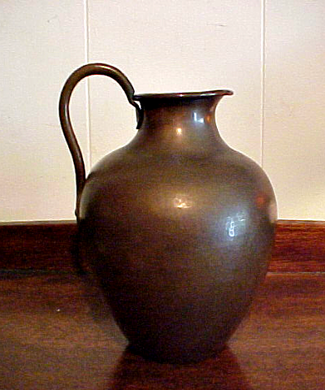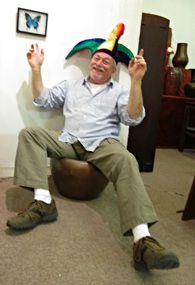There are more objects in the exhibition than are pictured on the website. Please come to see the show!
VIRTUALLY VAN ERP
AN OVERVIEW OF THE EXHIBITION
November 4, 2014
AN OVERVIEW OF THE EXHIBITION
November 4, 2014
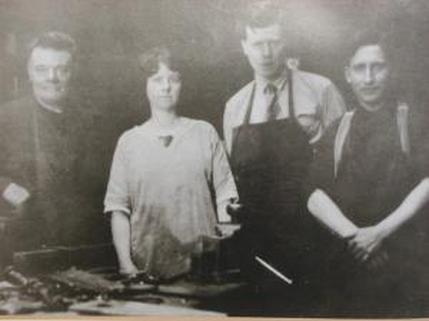 Dirk van Erp, Agatha van Erp, William van Erp, and August Tiesselink. Courtesy of the Oakland Museum, Dirk van Erp archives.
Dirk van Erp, Agatha van Erp, William van Erp, and August Tiesselink. Courtesy of the Oakland Museum, Dirk van Erp archives.
As the exhibition's opening is almost here, I'd like to say something about my intention in having put it all together. The high degree of excellence in craftsmanship, design, and execution in regard to the work from the bench of the Dirk van Erp studio is universally acknowledged. What has been understood and spoken about less is the fact that the studio and workshop was essentially a family-operated business for almost seven decades. While there were as many as a dozen or more other workers at times in some years, principally it was the family: Dirk, his son William, his daughter Agatha, and his nephew August who made the "wheels turn" and the copper bloom into glorious being. Dirk's initial partner in the San Francisco shop, D'Arcy Gaw, had the strongest impact on the growth of what had begun for van Erp in Vallejo as an offshoot of his utilitarian copper work and ensuing past time of hammering vases from artillery shells gathered at the Mare Island Naval shipyards where he worked. He had already started to "make a shop" of it in Oakland in 1908 when the two met in Alaska at the Alaska-Yukon-Pacific Exposition of 1909 as fellow exhibitors. That connection was to be the basis for a short-lived but critically important partnership which soon followed during which time van Erp moved to San Francisco to continue crafting. It was she, established artist/architect/teacher, who brought out of the senior van Erp the desire to raise his efforts in metal to something higher than perhaps he might have been able to envision and realize on his own. In 1910, in Bohemian San Francisco, filled with the frenzy of artists at work and the populace involved in developing industry of all sorts as the city re-built and resurrected itself up and out of its own ashes into the California skies again, D'Arcy Gaw and Dirk van Erp forged an alliance and created the foundation for what was to become known as one of the most illustrious twentieth century Art Metal shops in America. There were other accomplished crafters there like Harry Dixon who began working with van Erp very early on and, over the years, other crafters like Armen Herenian who were hired to hammer and raise metal at the van Erp shop. In time they both opened shops of their own. There were also artists like Benjamin Bufano, and students like Charles Anderson, brought in by his teacher, August Tiesselinck, who added their own style and flavor to the work which came out of the Dirk van Erp studio too. And countless others who exist today as names only. Perhaps in time, more of them will be named and their histories will be uncovered and our understanding of what really went on in the shop will grow. But at the heart of it, for most all the time until van Erp senior retired in 1930 were Dirk, William, Agatha, and August...
The studio and workshop of Dirk van Erp was, at its core, the family's going concern and creation. Each member of the four added something unique and wonderful to the body of its work and this exhibit focuses in the main on the D'Arcy Gaw association's pieces, a range of work by Dirk van Erp at the helm, examples of William's incredible tenure, (he worked with hammer in hand longer than his father-his work, elegantly planished and then buffed so that the hammering, while visible, was subordinate to the overall modernity and sweep of his designs), and by chance and good fortune, a portion on Agatha's unique influence, by showing wonderful pieces from the hand and hammer of Lucile Shear Bush whose enthusiasm and inspiration led her to form an alliance with Agatha and form the Metalcraft School here in San Francisco where Agatha taught women how to work in copper and silver.
Fortuitous Life. One day a month or two ago, as I was working on the exhibit, a woman stopped in front of my shop window and came back again after having perused the objects and photographs. I could see she was very interested in the photographs and copper pieces and so I stepped outside to speak with her. It soon became clear that Ellyn was the granddaughter of Lucile Bush. I told her I had met her grandmother some twenty-five years earlier and that she had been most generous to me with ideas and information and history when I was working on the Tiesselinck exhibition. It was through her grandmother that I first found out deeper information about the work that Agatha had done, teaching mostly upper class San Francisco society women the art of metalwork. It was canny and industrious on Agatha's part. After the women had crafted an object in one of her classes, they went home, shared their work, showing it to family and friends, and in the process spread the word about the van Erp studio where they might purchase fine objects in metal for themselves or as gifts on special occasions for others too. Ellyn has loaned a group of objects which show the range and quality of work which came out of Mrs. Bush's endeavor as well as a diminutive van Erp coffee service she had in her home.
And finally, there is August Tiesselinck, Dirk van Erp's nephew, who became the chief instructor and foreman of the shop, and an older brother of sorts to both William and Agatha. One has only to look at images of them together to see the deep regard and affection they all had for one another. And one can only imagine how much brother and sister profited from the advanced skill and caring of their cousin's company who had learned from an early age the art of fine metal smithing in Holland at the side of his uncle Yvo, goldsmith to the Queen. William and his wife, Josephine, remained life-long friends with August and his wife, Jean. They spent Sunday evening's in one another's homes weekly, together all their older days.In the book I wrote which accompanied the exhibition I had in the shop twenty-five years ago to introduce August Tiesselinck to the Arts and Crafts collecting public, I have already posited the many and specific influences and designs I believe came from his hand and heart.
So this little exhibit is meant to showcase the family and its influence on the studio with the remarkable name; and hopefully, it will open a small window into that intimate aspect of its creations.
"Thank you", again to Ellyn Bush whose very generous loan of her grandmother's work completes the show in a way I never could have without her fortuitous stop at my front door.
Isak Lindenauer November 4, 2014
The studio and workshop of Dirk van Erp was, at its core, the family's going concern and creation. Each member of the four added something unique and wonderful to the body of its work and this exhibit focuses in the main on the D'Arcy Gaw association's pieces, a range of work by Dirk van Erp at the helm, examples of William's incredible tenure, (he worked with hammer in hand longer than his father-his work, elegantly planished and then buffed so that the hammering, while visible, was subordinate to the overall modernity and sweep of his designs), and by chance and good fortune, a portion on Agatha's unique influence, by showing wonderful pieces from the hand and hammer of Lucile Shear Bush whose enthusiasm and inspiration led her to form an alliance with Agatha and form the Metalcraft School here in San Francisco where Agatha taught women how to work in copper and silver.
Fortuitous Life. One day a month or two ago, as I was working on the exhibit, a woman stopped in front of my shop window and came back again after having perused the objects and photographs. I could see she was very interested in the photographs and copper pieces and so I stepped outside to speak with her. It soon became clear that Ellyn was the granddaughter of Lucile Bush. I told her I had met her grandmother some twenty-five years earlier and that she had been most generous to me with ideas and information and history when I was working on the Tiesselinck exhibition. It was through her grandmother that I first found out deeper information about the work that Agatha had done, teaching mostly upper class San Francisco society women the art of metalwork. It was canny and industrious on Agatha's part. After the women had crafted an object in one of her classes, they went home, shared their work, showing it to family and friends, and in the process spread the word about the van Erp studio where they might purchase fine objects in metal for themselves or as gifts on special occasions for others too. Ellyn has loaned a group of objects which show the range and quality of work which came out of Mrs. Bush's endeavor as well as a diminutive van Erp coffee service she had in her home.
And finally, there is August Tiesselinck, Dirk van Erp's nephew, who became the chief instructor and foreman of the shop, and an older brother of sorts to both William and Agatha. One has only to look at images of them together to see the deep regard and affection they all had for one another. And one can only imagine how much brother and sister profited from the advanced skill and caring of their cousin's company who had learned from an early age the art of fine metal smithing in Holland at the side of his uncle Yvo, goldsmith to the Queen. William and his wife, Josephine, remained life-long friends with August and his wife, Jean. They spent Sunday evening's in one another's homes weekly, together all their older days.In the book I wrote which accompanied the exhibition I had in the shop twenty-five years ago to introduce August Tiesselinck to the Arts and Crafts collecting public, I have already posited the many and specific influences and designs I believe came from his hand and heart.
So this little exhibit is meant to showcase the family and its influence on the studio with the remarkable name; and hopefully, it will open a small window into that intimate aspect of its creations.
"Thank you", again to Ellyn Bush whose very generous loan of her grandmother's work completes the show in a way I never could have without her fortuitous stop at my front door.
Isak Lindenauer November 4, 2014
|
|
***********************************************************************************
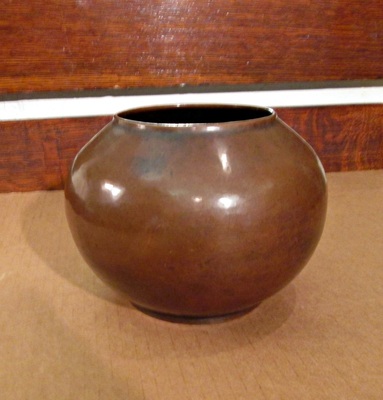 While I live with larger and more complex vase forms, I think this vase has always been my favorite.
While I live with larger and more complex vase forms, I think this vase has always been my favorite.
Zen metal. Clean. Elegant. Pure. Subtle. Realized.
Those of us who are passionate about the work of
the Dirk van Erp studio see in it a timeless, functional
beauty given form.
******************
New images added November 10th.
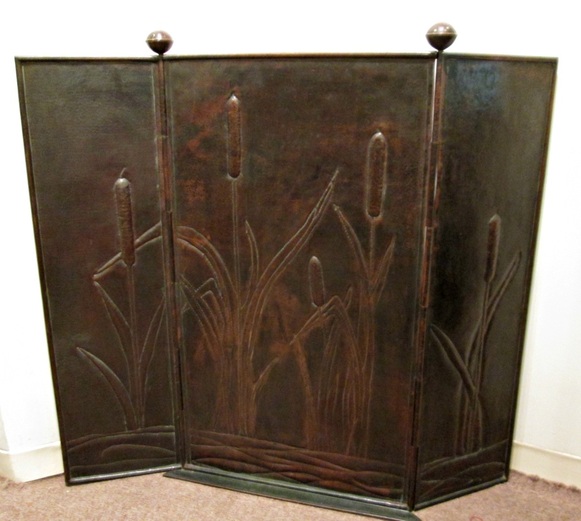 The D'Arcy Gaw cattail fire screen, c. 1909
The D'Arcy Gaw cattail fire screen, c. 1909
The D'Arcy Gaw cattail firescreen
I had hoped to write an essay on D'Arcy Gaw prompted by the showing of the cattail screen. Unfortunately, it appears there will not be enough time for me to do that. Instead, I am adding a section below with some information on her life and work.
This excerpt from The San Francisco Call, volume six, set 12, 1909: "Miss d'Arcy Gaw and Dirk Van Erp will open their studio and workshop in Sutter street the early part of next week. Miss Gaw who has been; teaching for the last two or three months at the summer school, will open a private class for instruction in designing and metal work. For a number of years she was associated in business with Lawrence Buck, the well-known Chicago architect.
While she has severed her actual connection with him, they still do much of their work in conjunction, as she makes many of the floor plans and designs the interior decorating of his houses. Her specialty is interior decorating but she has also won quite a name for herself for her hand Wrought metal work and her designs in Jewelry.
One of the most attractive pieces in her studio is a hand made box In beaten copper, and her designs for electric light fixtures, lamps and screens are particularly effective. She has recently completed the work on the homes of Henry Gaw and J. R. Thompson in San Jose and is at present busy with the floor plans and conventional Interior designing of the house Mrs. H. Campbell Is erecting in Palo Alto."
I had hoped to write an essay on D'Arcy Gaw prompted by the showing of the cattail screen. Unfortunately, it appears there will not be enough time for me to do that. Instead, I am adding a section below with some information on her life and work.
This excerpt from The San Francisco Call, volume six, set 12, 1909: "Miss d'Arcy Gaw and Dirk Van Erp will open their studio and workshop in Sutter street the early part of next week. Miss Gaw who has been; teaching for the last two or three months at the summer school, will open a private class for instruction in designing and metal work. For a number of years she was associated in business with Lawrence Buck, the well-known Chicago architect.
While she has severed her actual connection with him, they still do much of their work in conjunction, as she makes many of the floor plans and designs the interior decorating of his houses. Her specialty is interior decorating but she has also won quite a name for herself for her hand Wrought metal work and her designs in Jewelry.
One of the most attractive pieces in her studio is a hand made box In beaten copper, and her designs for electric light fixtures, lamps and screens are particularly effective. She has recently completed the work on the homes of Henry Gaw and J. R. Thompson in San Jose and is at present busy with the floor plans and conventional Interior designing of the house Mrs. H. Campbell Is erecting in Palo Alto."
*******************************************************************
Here are some excerpts from an article on D'Arcy Gaw, Designing Woman, which first appeared in Gentry magazine, Menlo Park, about 2008. It was written by local writer, Alice Kaufman, who writes for The Maine Antique Digest, and other trade journals dealing with fine art and antiques.
"Today, D'arcy Gaw is remembered for her work with Arts and Crafts superstar Dirk van Erp, but some experts believe that he is remembered because of her.
She was a star before she got here. By the time she moved to San Jose in 1904, she had already graduated from the Art Institute of Chicago, and had made a name for herself as an architect, a designer (of both residential interiors and decorative accessories), and an exhibited and accomplished metalworker.
Her work as an architect in San Jose was featured in House Beautiful, April, 1909, in a story called "An Arts and Crafts House." From the text: "The house herewith presented is the joint work of Mr. Lawrence Buck and Miss D'arcy Gaw, and is located in San Jose. Miss Gaw drew the floor plans and Mr. Buck the elevations. The specifications were made by Miss Gaw who supervised the construction and planned the entire interior scheme, designing mos of the furniture and all the furnishings." The house, which was located at 6 Northup Avenue at the corner of Pedro Street, was built for her father... The house was demolished in the 1950s.
While she lived in San Jose in 1907, Gaw worked as an assistant to San Jose coppersmith Lillian Palmer in Palmer's studio in the basement of Palmer's Naglee Park home. In 1910 Palmer opened the Palmer Copper Shop in San Francisco. Although the Palmer shop closed after just eight years, Palmer's lamps are among the era's most beautiful and collectible.
To quote the San Francisco Chronicle from a January 17, 1917 story, "The Palmer Copper Shop specializes in designing fixtures which not only attain the desired lighting effects in a given room, but also conform to the style and contour of the room and the usage to which it is to be put. Its substantial and widespread success is indicated by the fact that its electric fixtures are sought for and shipped to New York, Alaska, and Mexico. Last year the exhibit maintained by The Palmer Copper Shop at the Varied Industries building of the Exposition was one of the stellar exhibits displayed."
1910 was a good year for copper in San Francisco; along with the Palmer Copper Shop, Dirk van Erp opened his Copper Shop with D'arcy Gaw as his partner. Although their professional partnership lasted less than a year, it was her association with him that made both of them icons of America's Arts and Crafts movement.
When van Erp opened the Copper Shop, "it established an identity rather quickly, lasted the longest, and was the most prolific," wrote Kenneth R. Trapp in "The Arts and crafts Movement in the San Francisco Bay Area," a chapter in "The Arts and Crafts Movement in California: Living the Good Life." Trapp continues, "The van Erp enterprise set the artistic and technical standards for handwrought copper in San Francisco, provided apprenticeship opportunities for a few students and became a venerated San Francisco institution that operated for 67 years until 1977."...
Before joining forces with Gaw, van Erp opened shops in Oakland in 1908 and 1909. His earliest specialty was hammering artillery shells into vases."...
"...Many people believe that it was D'arcy Gaw who introduced van Erp to making the utilitarian but beautiful lamps that would make his (and, for a while, her) name"....
"By 1910, van Erp was ready to open a shop in San Francisco, and he turned to Gaw. She was already working in the city...." "...and she was president of the San Francisco Guild of Arts and Crafts. In addition, Gaw's innate and schooled sense of style and design, and the knowledge of and experience in making electric lamps she picked up when she worked with Lillian Palmer, seem to have made her an ideal candidate to be a partner in the ambitious copper shop.
Although no one knows how van Erp and Gaw met, one theory is that they met at the Alaska Yukon Exhibit in Seattle in 1909...."
"...To Kenneth Trapp, "despite the brevity of Gaw's partnership with van Erp, she is believed to have exerted strong influence on the designs of the van Erp studio." These include lamps, the form that made and kept van Erp famous, as well as vases, candlesticks, boxes and more...."
"... Very little is known about Gaw's career after her partnership with van Erp. She works as a designer for Herter Looms, a carpet company in San Francisco. in 1911, she returns to Illinois. She shares studio space with architect Lawrence Buck in Chicago, designs at least one house with him, and works as an interior decorator and a designer. She returns to San Jose in 1915, where she works as a designer through 1919. In 1933, she is listed as an interior designer in New York City. She died in Pacific Grove in 1944..."
Here are some excerpts from an article on D'Arcy Gaw, Designing Woman, which first appeared in Gentry magazine, Menlo Park, about 2008. It was written by local writer, Alice Kaufman, who writes for The Maine Antique Digest, and other trade journals dealing with fine art and antiques.
"Today, D'arcy Gaw is remembered for her work with Arts and Crafts superstar Dirk van Erp, but some experts believe that he is remembered because of her.
She was a star before she got here. By the time she moved to San Jose in 1904, she had already graduated from the Art Institute of Chicago, and had made a name for herself as an architect, a designer (of both residential interiors and decorative accessories), and an exhibited and accomplished metalworker.
Her work as an architect in San Jose was featured in House Beautiful, April, 1909, in a story called "An Arts and Crafts House." From the text: "The house herewith presented is the joint work of Mr. Lawrence Buck and Miss D'arcy Gaw, and is located in San Jose. Miss Gaw drew the floor plans and Mr. Buck the elevations. The specifications were made by Miss Gaw who supervised the construction and planned the entire interior scheme, designing mos of the furniture and all the furnishings." The house, which was located at 6 Northup Avenue at the corner of Pedro Street, was built for her father... The house was demolished in the 1950s.
While she lived in San Jose in 1907, Gaw worked as an assistant to San Jose coppersmith Lillian Palmer in Palmer's studio in the basement of Palmer's Naglee Park home. In 1910 Palmer opened the Palmer Copper Shop in San Francisco. Although the Palmer shop closed after just eight years, Palmer's lamps are among the era's most beautiful and collectible.
To quote the San Francisco Chronicle from a January 17, 1917 story, "The Palmer Copper Shop specializes in designing fixtures which not only attain the desired lighting effects in a given room, but also conform to the style and contour of the room and the usage to which it is to be put. Its substantial and widespread success is indicated by the fact that its electric fixtures are sought for and shipped to New York, Alaska, and Mexico. Last year the exhibit maintained by The Palmer Copper Shop at the Varied Industries building of the Exposition was one of the stellar exhibits displayed."
1910 was a good year for copper in San Francisco; along with the Palmer Copper Shop, Dirk van Erp opened his Copper Shop with D'arcy Gaw as his partner. Although their professional partnership lasted less than a year, it was her association with him that made both of them icons of America's Arts and Crafts movement.
When van Erp opened the Copper Shop, "it established an identity rather quickly, lasted the longest, and was the most prolific," wrote Kenneth R. Trapp in "The Arts and crafts Movement in the San Francisco Bay Area," a chapter in "The Arts and Crafts Movement in California: Living the Good Life." Trapp continues, "The van Erp enterprise set the artistic and technical standards for handwrought copper in San Francisco, provided apprenticeship opportunities for a few students and became a venerated San Francisco institution that operated for 67 years until 1977."...
Before joining forces with Gaw, van Erp opened shops in Oakland in 1908 and 1909. His earliest specialty was hammering artillery shells into vases."...
"...Many people believe that it was D'arcy Gaw who introduced van Erp to making the utilitarian but beautiful lamps that would make his (and, for a while, her) name"....
"By 1910, van Erp was ready to open a shop in San Francisco, and he turned to Gaw. She was already working in the city...." "...and she was president of the San Francisco Guild of Arts and Crafts. In addition, Gaw's innate and schooled sense of style and design, and the knowledge of and experience in making electric lamps she picked up when she worked with Lillian Palmer, seem to have made her an ideal candidate to be a partner in the ambitious copper shop.
Although no one knows how van Erp and Gaw met, one theory is that they met at the Alaska Yukon Exhibit in Seattle in 1909...."
"...To Kenneth Trapp, "despite the brevity of Gaw's partnership with van Erp, she is believed to have exerted strong influence on the designs of the van Erp studio." These include lamps, the form that made and kept van Erp famous, as well as vases, candlesticks, boxes and more...."
"... Very little is known about Gaw's career after her partnership with van Erp. She works as a designer for Herter Looms, a carpet company in San Francisco. in 1911, she returns to Illinois. She shares studio space with architect Lawrence Buck in Chicago, designs at least one house with him, and works as an interior decorator and a designer. She returns to San Jose in 1915, where she works as a designer through 1919. In 1933, she is listed as an interior designer in New York City. She died in Pacific Grove in 1944..."
***********************************************
Next, an image of D'Arcy Gaw's San Jose home and the house she designed for her father, Henry Gaw, featured in House Beautiful in April of 1909.
Next, an image of D'Arcy Gaw's San Jose home and the house she designed for her father, Henry Gaw, featured in House Beautiful in April of 1909.
***************************************
Another strong influence on the van Erp crafters was Yvo van Erp, August Tiesselinck's uncle. Here is a rare piece of Yvo's handwork and to its right, executed in copper rather than silver, a box by Dirk van Erp, clearly influenced by his technique and choice of subject matter: Fine Art.
Another strong influence on the van Erp crafters was Yvo van Erp, August Tiesselinck's uncle. Here is a rare piece of Yvo's handwork and to its right, executed in copper rather than silver, a box by Dirk van Erp, clearly influenced by his technique and choice of subject matter: Fine Art.
************************************
More of the studio's handwork, starting with the highly important and very beautiful Dirk van Erp red warty milk can table lamp, another rare example of the studio's artistic craft.
More of the studio's handwork, starting with the highly important and very beautiful Dirk van Erp red warty milk can table lamp, another rare example of the studio's artistic craft.
Followed by a number of other forms in the van Erp lexicon...
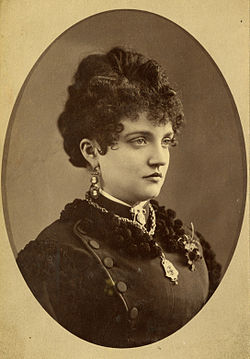
Baby Doe Tabor From Wikipedia, the free encyclopedia
Baby Doe Tabor, circa 1883
"Elizabeth McCourt Tabor (1854 – March 7, 1935), better known as Baby Doe, was the second wife of pioneer Colorado businessman Horace Tabor. Born in Oshkosh, Wisconsin, she moved to Colorado in the mid-1870s with her first husband, Harvey Doe, whom she divorced for drinking, gambling, frequenting brothels, and being unable to provide a living.
She then moved to Leadville, Colorado, where she met Tabor, a wealthy silver magnate almost twice her age. In 1883 he divorced his first wife, to whom he had been married for 25 years, and married Baby Doe in Washington, D.C. during his brief stint as a US senator, after which they took up residence in Denver. His divorce and remarriage to the young and beautiful Baby Doe caused a scandal in 1880s Colorado. Although Tabor was one of the wealthiest men in Colorado, supporting his wife in a lavish style, he lost his fortune when the repeal of the Sherman Silver Purchase Act caused the Panic of 1893 with widespread bankruptcies in silver-producing regions such as Colorado. He died destitute, and she returned to Leadville with her two daughters, living out the rest of her life there.
At one time the "best dressed woman in the West",[1] for the final three decades of her life, she lived in a shack on the site of the Matchless Mine, enduring great poverty, solitude, and repentance. After a snowstorm in March 1935, she was found frozen in her cabin, aged about 81 years.[1] During her lifetime she became the subject of malicious gossip and scandal, defied Victorian gender values, and gained a "reputation of one of the most beautiful, flamboyant, and alluring women in the mining West".[2] ...."
This rare, early example comes from the Tabor estate. Baby Doe's story, which I will not print in full here, is too like the most extravagant of soap operas, too unimaginable not to enchant and confound. I give the link here and suggest those who have interest, read the tale of Baby Doe... deemed a great beauty at an early age, her many loves, her marriage to Horace who became Colorado's Lieutenant Governor, their fabulous wealth from silver from the Matchless Mine, his death and her descent into madness which left her a literal ragwoman, burlap strips wrapped around her legs, dressed in a mixture of men's and women's clothing, mining boots, roaming the streets of Leadville for thirty years or more.
"Judy Nolte Temple writes that Baby Doe's legend, and her sins, grew quickly in retelling...She was rumored to be a gold-digger and a poor mother. Scavengers searched for non-existent treasure after her death, but Temple says the real treasure was found in Baby Doe's writing, which has taken decades to archive, analyze and study, and only now is beginning to reveal the inner life of the woman.[31] Temple sees her as one in a long line of women who endured shunning and punishment for her beauty and for being disruptive to prevailing social norms. Temple speculates that Baby Doe's move to Leadville after Horace's death may have been self-shunning from Denver society.[22]"
http://en.wikipedia.org/wiki/Baby_Doe_Tabor
************************************************
Baby Doe Tabor, circa 1883
"Elizabeth McCourt Tabor (1854 – March 7, 1935), better known as Baby Doe, was the second wife of pioneer Colorado businessman Horace Tabor. Born in Oshkosh, Wisconsin, she moved to Colorado in the mid-1870s with her first husband, Harvey Doe, whom she divorced for drinking, gambling, frequenting brothels, and being unable to provide a living.
She then moved to Leadville, Colorado, where she met Tabor, a wealthy silver magnate almost twice her age. In 1883 he divorced his first wife, to whom he had been married for 25 years, and married Baby Doe in Washington, D.C. during his brief stint as a US senator, after which they took up residence in Denver. His divorce and remarriage to the young and beautiful Baby Doe caused a scandal in 1880s Colorado. Although Tabor was one of the wealthiest men in Colorado, supporting his wife in a lavish style, he lost his fortune when the repeal of the Sherman Silver Purchase Act caused the Panic of 1893 with widespread bankruptcies in silver-producing regions such as Colorado. He died destitute, and she returned to Leadville with her two daughters, living out the rest of her life there.
At one time the "best dressed woman in the West",[1] for the final three decades of her life, she lived in a shack on the site of the Matchless Mine, enduring great poverty, solitude, and repentance. After a snowstorm in March 1935, she was found frozen in her cabin, aged about 81 years.[1] During her lifetime she became the subject of malicious gossip and scandal, defied Victorian gender values, and gained a "reputation of one of the most beautiful, flamboyant, and alluring women in the mining West".[2] ...."
This rare, early example comes from the Tabor estate. Baby Doe's story, which I will not print in full here, is too like the most extravagant of soap operas, too unimaginable not to enchant and confound. I give the link here and suggest those who have interest, read the tale of Baby Doe... deemed a great beauty at an early age, her many loves, her marriage to Horace who became Colorado's Lieutenant Governor, their fabulous wealth from silver from the Matchless Mine, his death and her descent into madness which left her a literal ragwoman, burlap strips wrapped around her legs, dressed in a mixture of men's and women's clothing, mining boots, roaming the streets of Leadville for thirty years or more.
"Judy Nolte Temple writes that Baby Doe's legend, and her sins, grew quickly in retelling...She was rumored to be a gold-digger and a poor mother. Scavengers searched for non-existent treasure after her death, but Temple says the real treasure was found in Baby Doe's writing, which has taken decades to archive, analyze and study, and only now is beginning to reveal the inner life of the woman.[31] Temple sees her as one in a long line of women who endured shunning and punishment for her beauty and for being disruptive to prevailing social norms. Temple speculates that Baby Doe's move to Leadville after Horace's death may have been self-shunning from Denver society.[22]"
http://en.wikipedia.org/wiki/Baby_Doe_Tabor
************************************************
A selection of silver on copper and sterling pieces among those which will be shown in: "Dirk van Erp - Copper Shop" opening this November 15th.
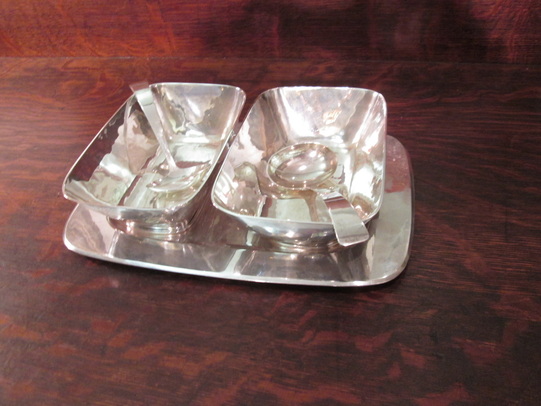 Silver condiment set with sterling serving spoons by Dirk van Erp.
Silver condiment set with sterling serving spoons by Dirk van Erp.
And other examples in copper and various other metal also in the exhibit:
Dirk van erp tea pot, 8" H Dirk van Erp teapot 6 1/2" H August Tiesselinck tea kettle 8 1/2" H,
on van Erp footed stand.
on van Erp footed stand.
Copyright © 2014-2021 Isak Lindenauer
